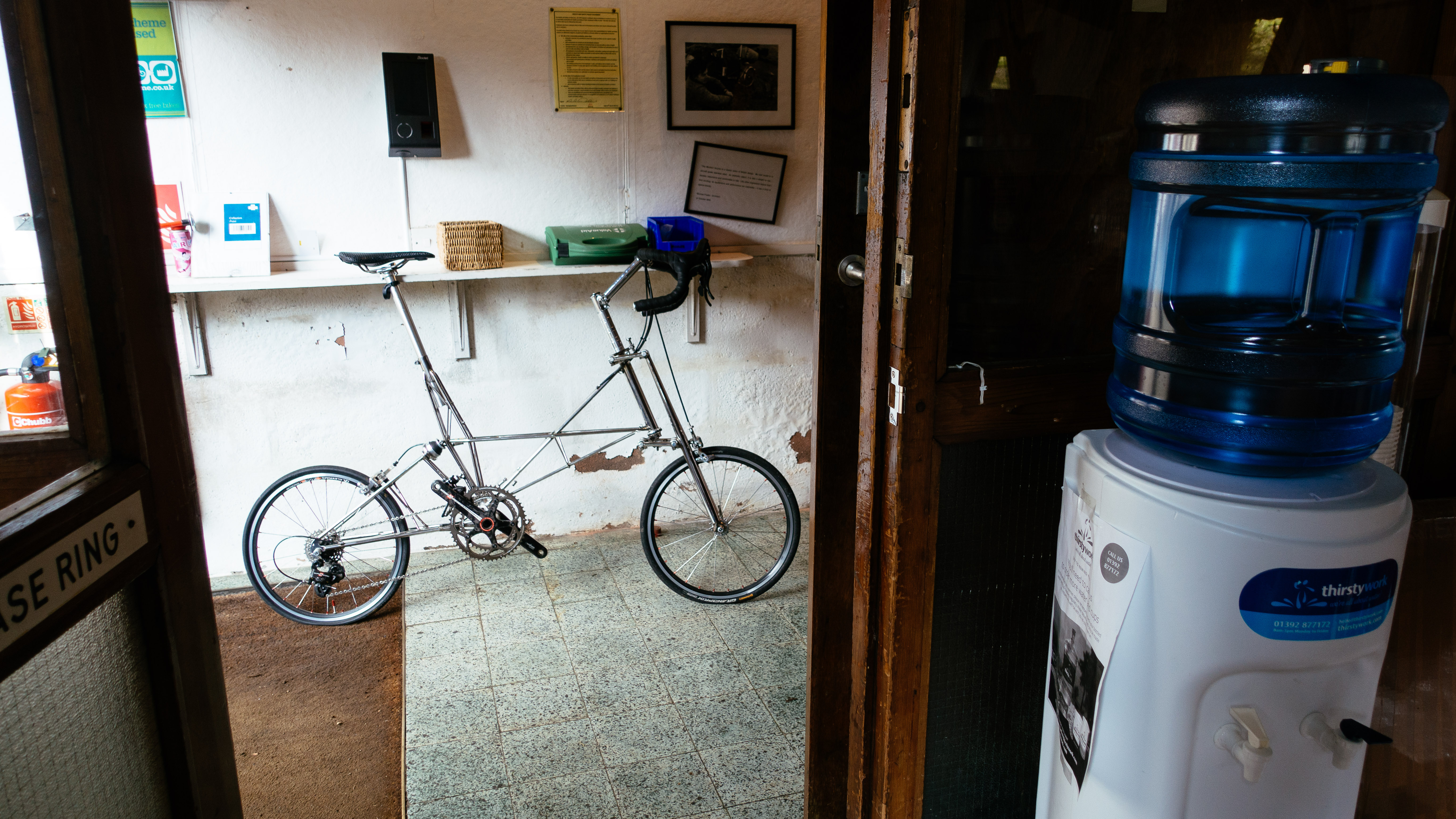

As I sit on a slightly rattly, two-carriage train, the steel, glass, and concrete of Bristol quickly give way to brown-green dappled fields, many still flooded from a tremendously wet February. The March sun is doing its level best to burn through the heavy clouds, but it's still a little too anaemic, despite what the daffodils would have you believe.
I've passed through many postcard-named stations on my way to Bradford on Avon, a stone's throw in relative terms from the Cyclingnews office. Here is where Moulton bikes are still produced, and though you may well have never laid eyes on one either in person or digitally, the brand has a storied history.
I’m met at the station by Steve, the company’s head of sales, armed with two Moultons, and we immediately glide through town and onto the Kennet and Avon canal path. If, in your mind’s eye, picture ‘English postcard town’ you’ve got a fair idea of what Bradford on Avon and its attendant canal is like; extremely pretty, despite the fact it was, until rather recently, underwater.
Glide is the operative word, as the Moulton betwixt my legs, is blessed with both front and rear suspension. It’s far more pillowy than similarly travelled modern suspension forks, the likes of which you’d find on a YT Szepter for example. The ride over a rutted canal towpath is slightly lolloping, reminiscent of the train carriage I had only recently alighted.
They say a picture tells a thousand words (though my editor still refuses to pay a word rate on this basis...), and so below I'll walk through my journey into Moulton's factory, and the endearing history of a cult British cycling brand, in images.

In at the deep end; straight off the train and onto a Moulton, and along a mucky canal towpath.
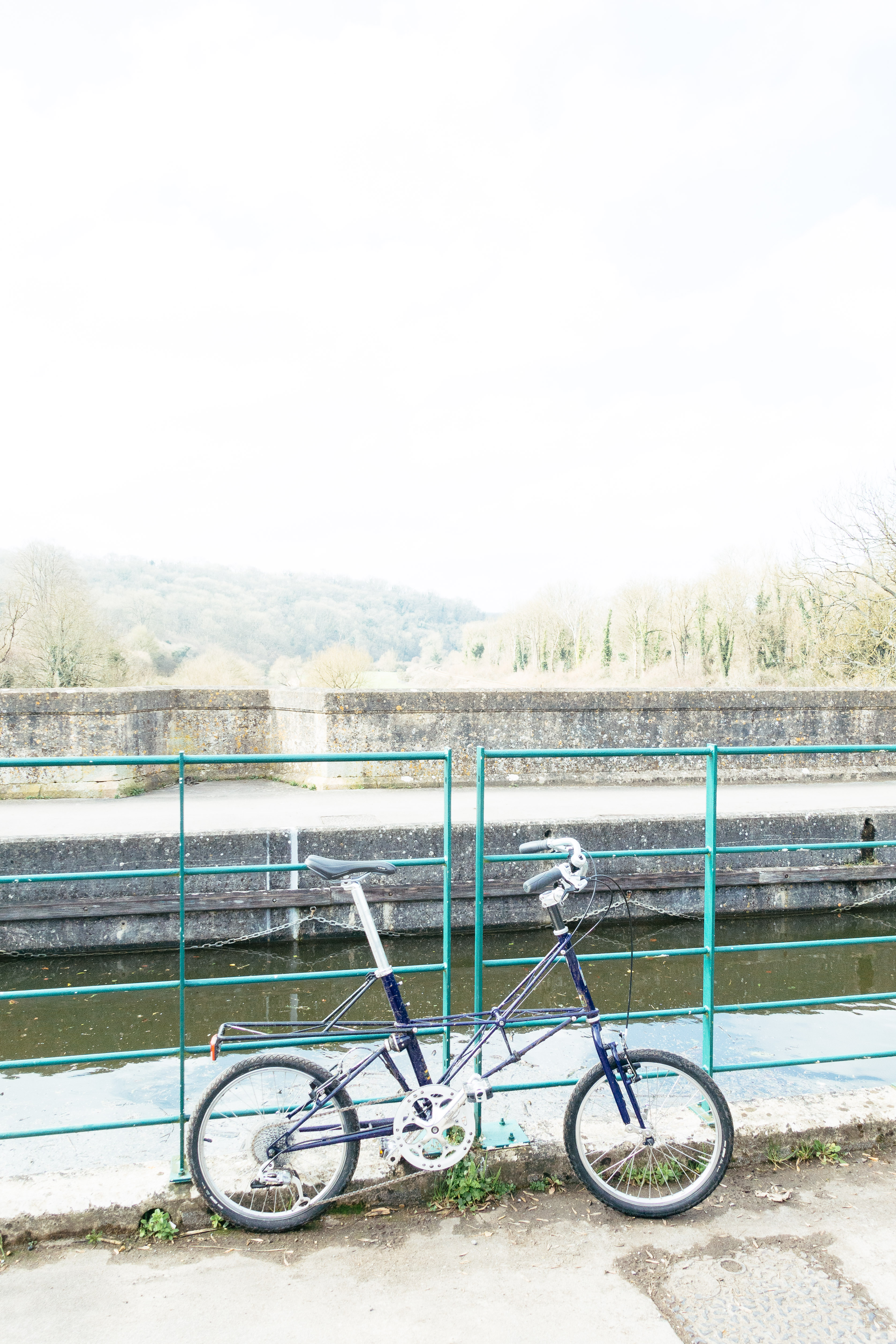
We waited here a while, talked about a pub that sady wasn't open, and watched a train go by. Extremely bucolic.
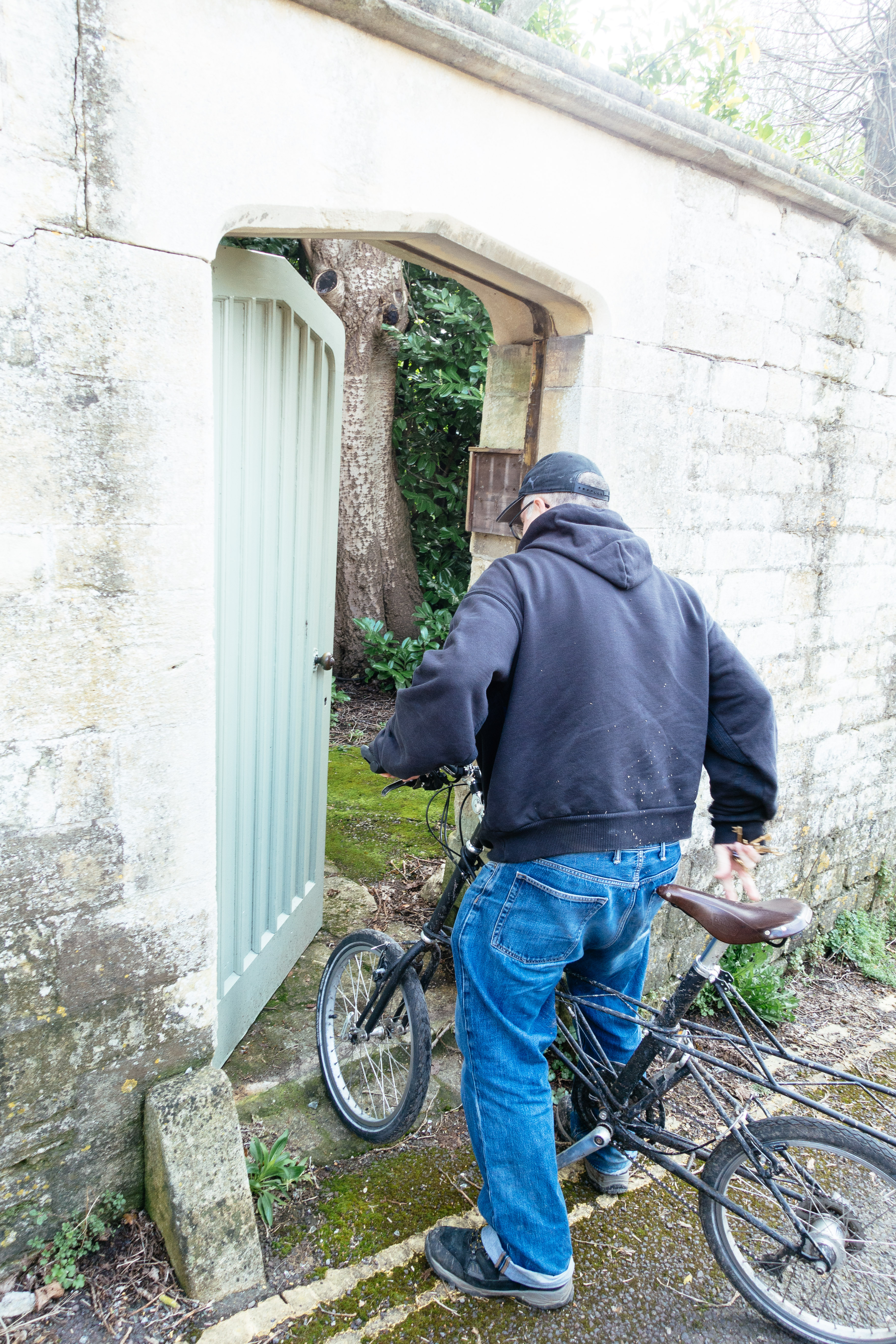
Into the estate/factory, which made me feel a bit like I was breaking and entering.
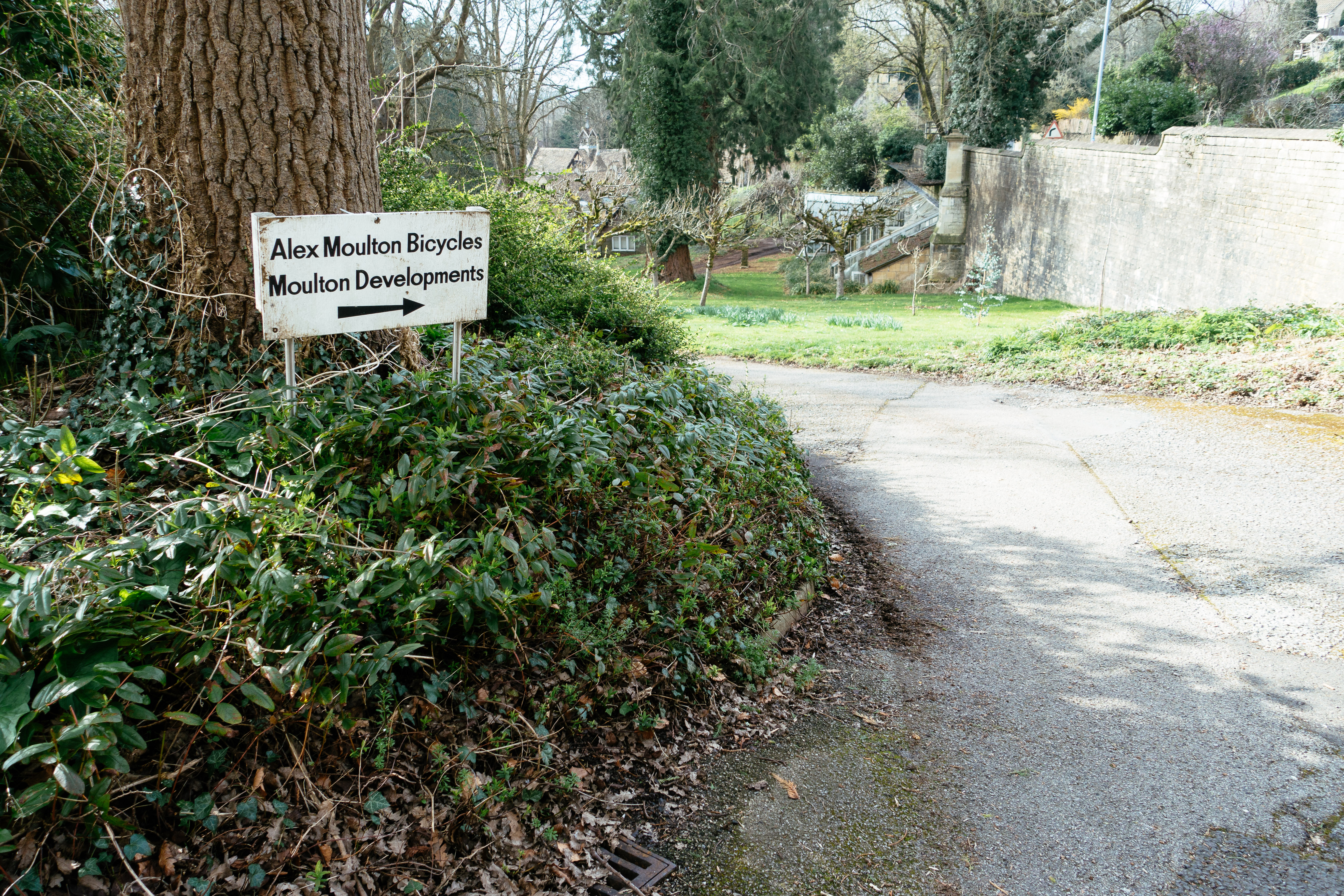
The signage has had very few updates over the years; if it ain't broke, don't fix it.
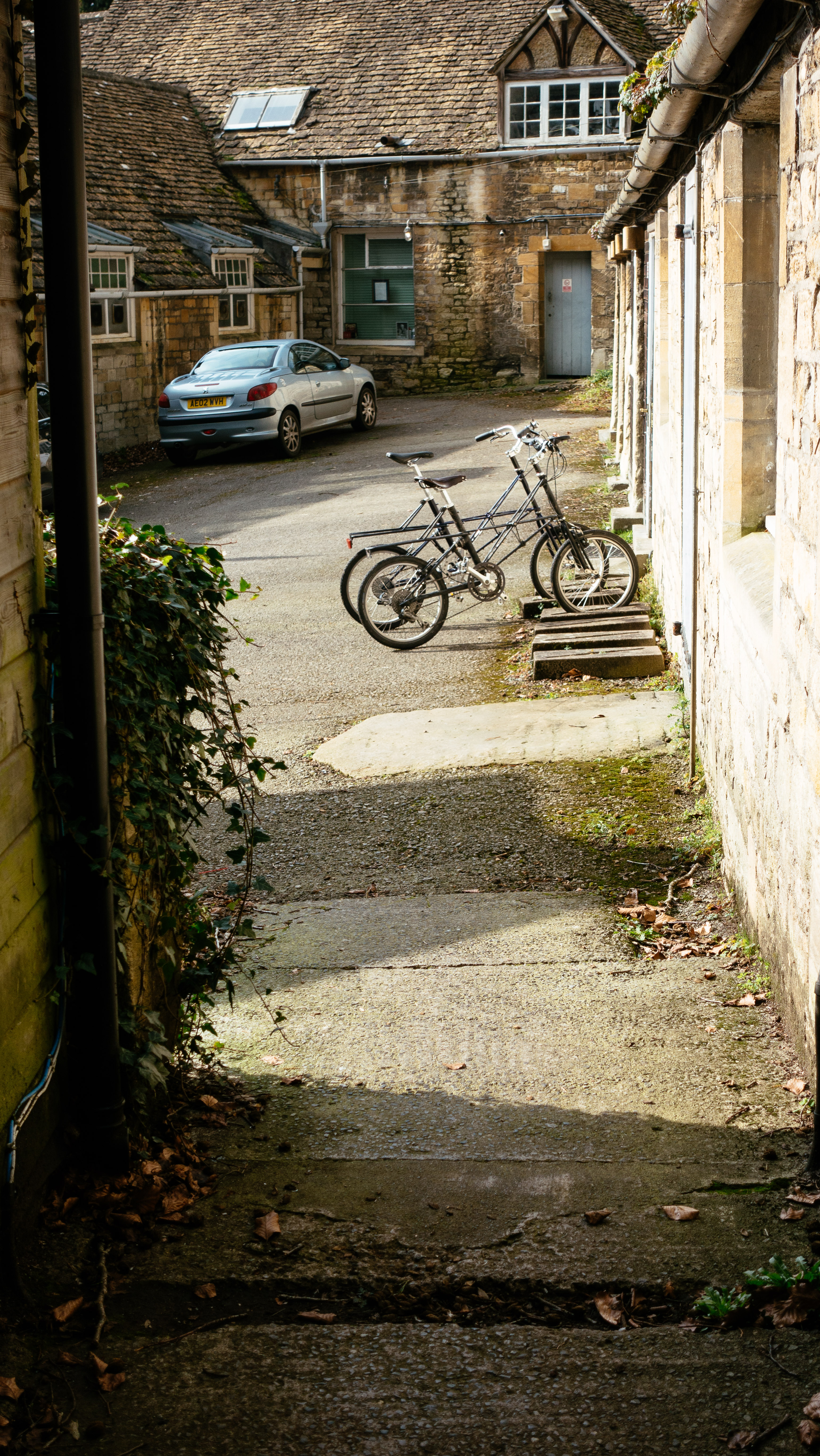
Parked up outside one of the workshops are our two bikes from the test fleet. More basic models to give riders and would-be purchasers a flavour, without getting the really fancy bikes filthy.
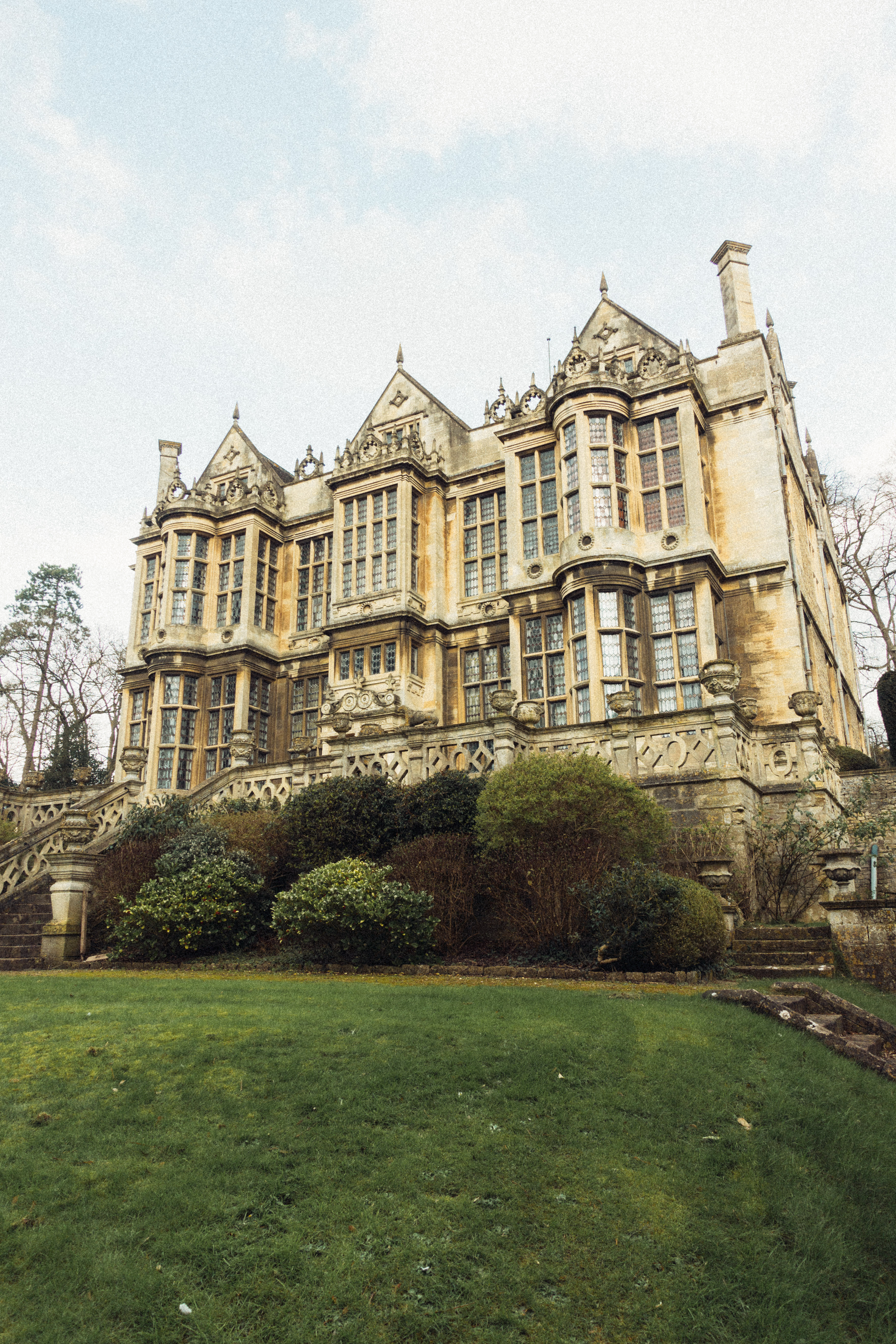
I challenge you to find a bike factory anywhere else with buildings like this.
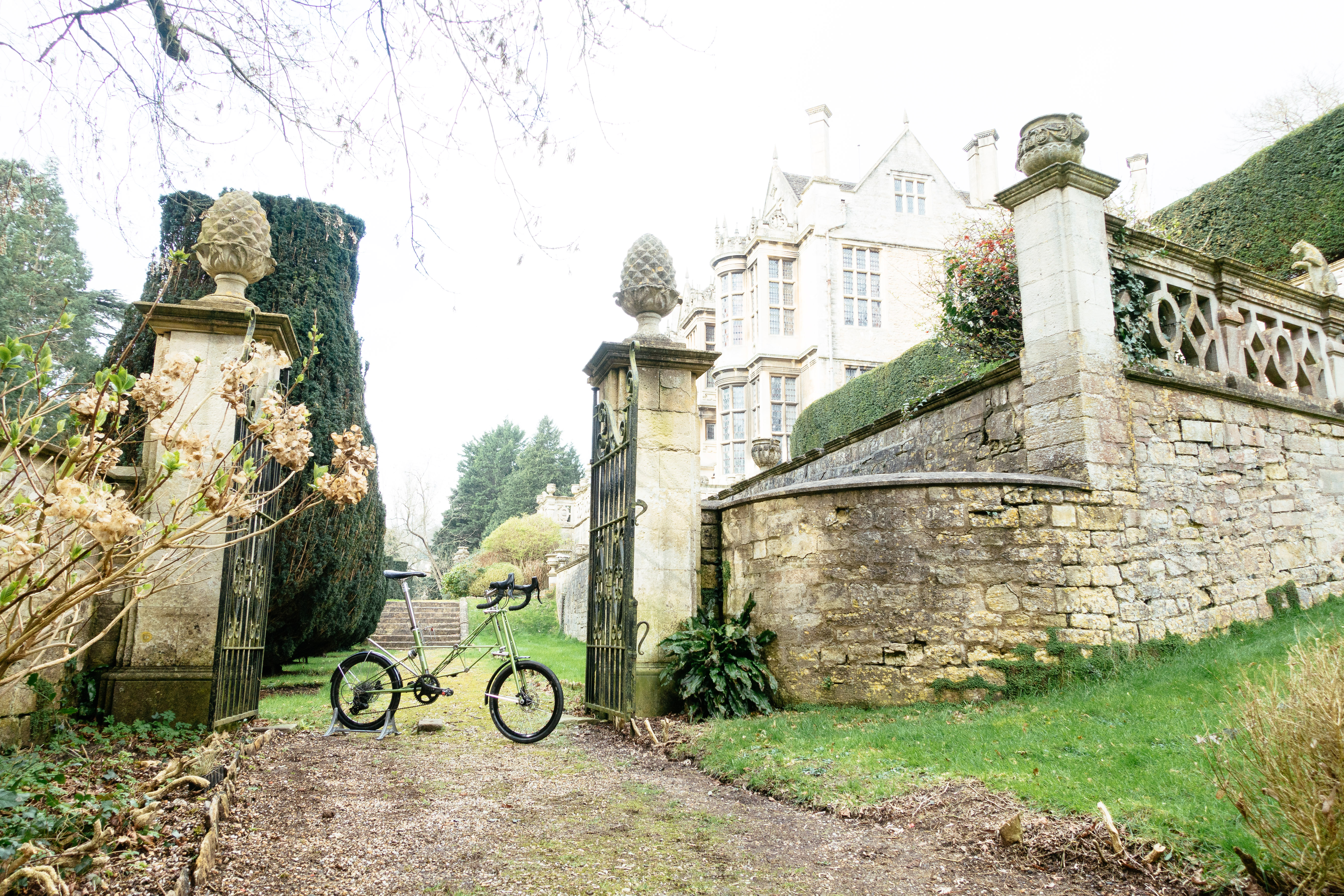
The intricate trusses of the bikes mirror the architectural details to some degree.
To understand Moulton you need to understand Alex Moulton, the brand’s founder. A designer/engineer worthy of being mentioned amongst other such British designers/engineers like James Dyson, Barnes Wallace, and Colin Chapman. Before turning his hand to bicycle manufacturer, Alex Moulton designed the suspension for the original Mini. This suspension was in effect miniaturised and built into early models, though these had a far more boxy appearance than today at their inception in the ‘60’s.
Down the line the designs were updated to the space frame models in production to this day; all narrow tubes, trusses, and triangles. The models proliferated from the original, utilitarian around-town models to include ever lighter and more purposeful options, and the eventual introduction of rear suspension, which in conjunction with wider tyres in effect creating the world's first full suspension mountain bike, though it’s a far cry modern mountain bikes and is perhaps more akin to a lightly suspended gravel bike.

Lovingly leant up in the office to await its re-polishing treatment.
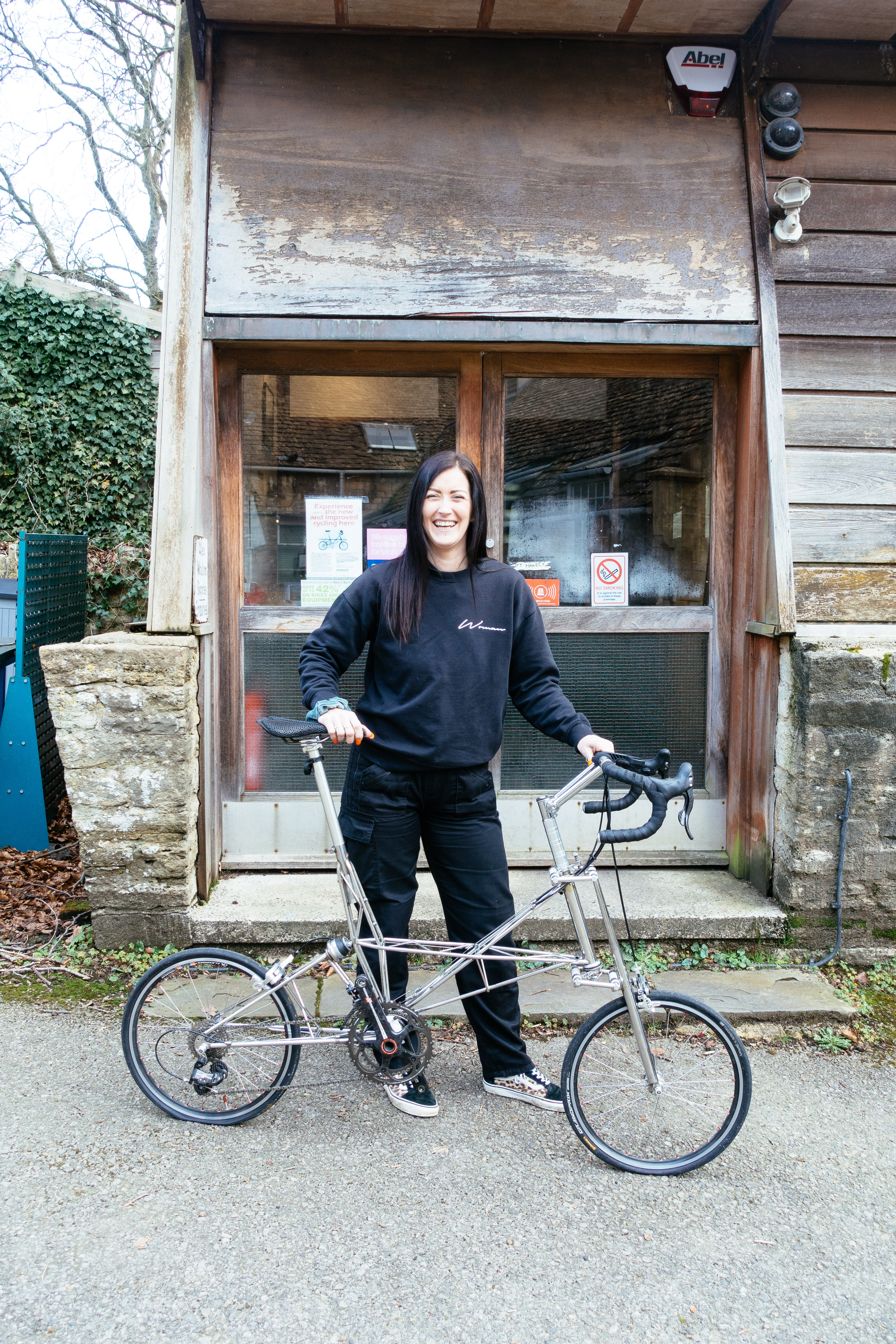
Outside the main office I'm shown a lovely polished stainless model, built up with a classic 5-arm Campagnolo Super Record groupset, that had been sent back to the factory for a polish.
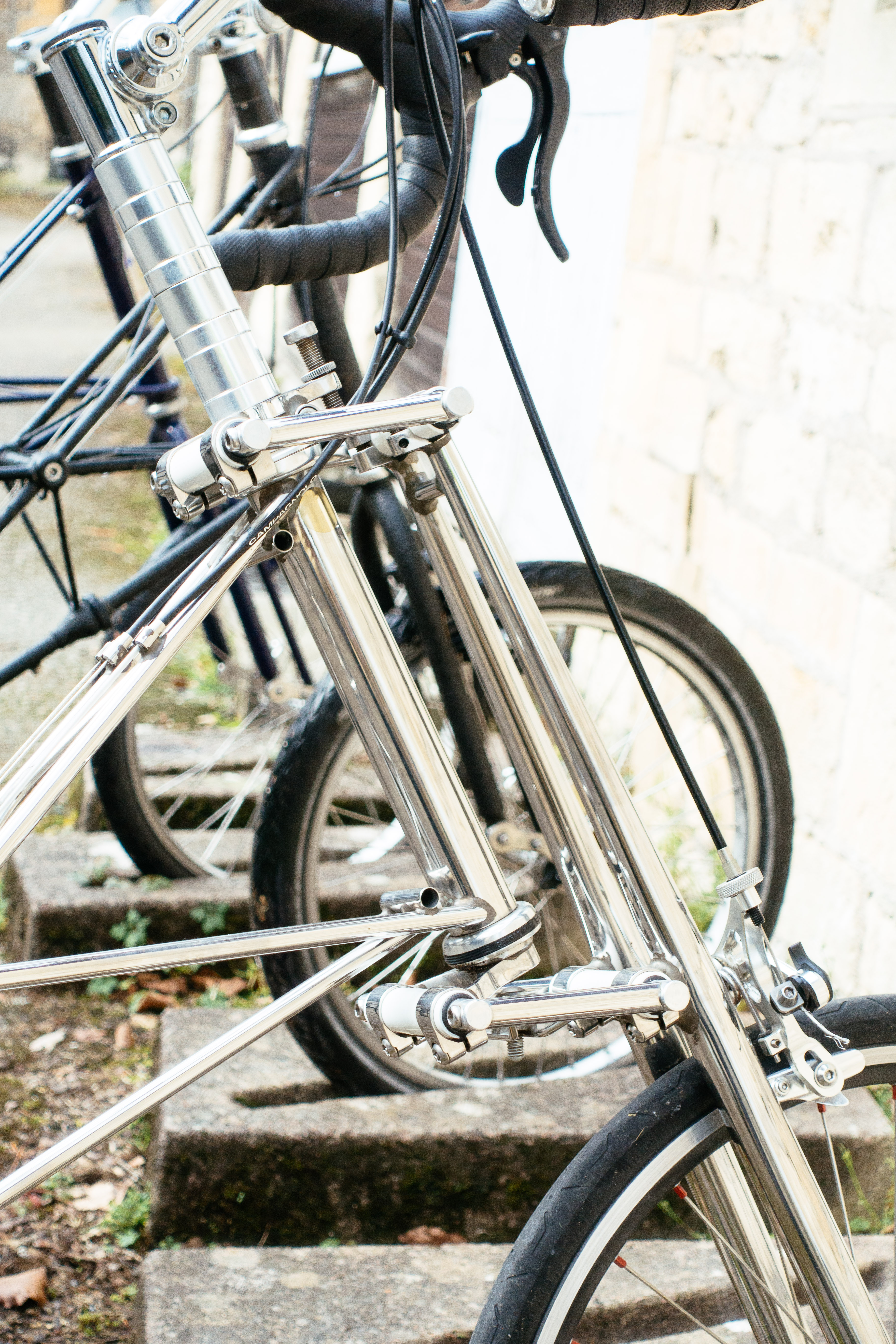
Even as a relatively competent bicycle mechanic, I feel like I'd be out of my depth if I had to put one of these together.

Cross Iceland on 20" wheels? No problem!
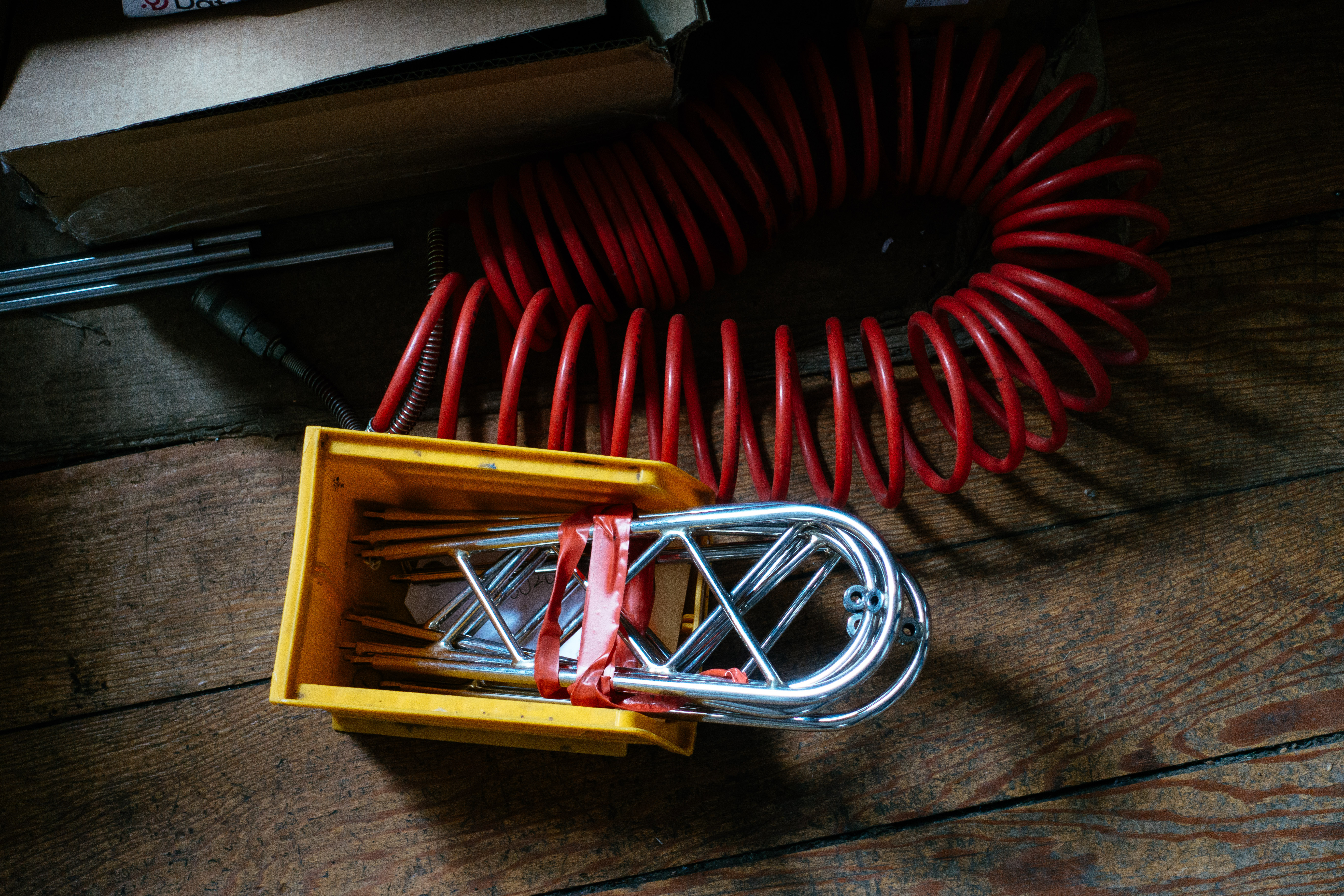
Some stainless racks on the office floor catch the sunlight.
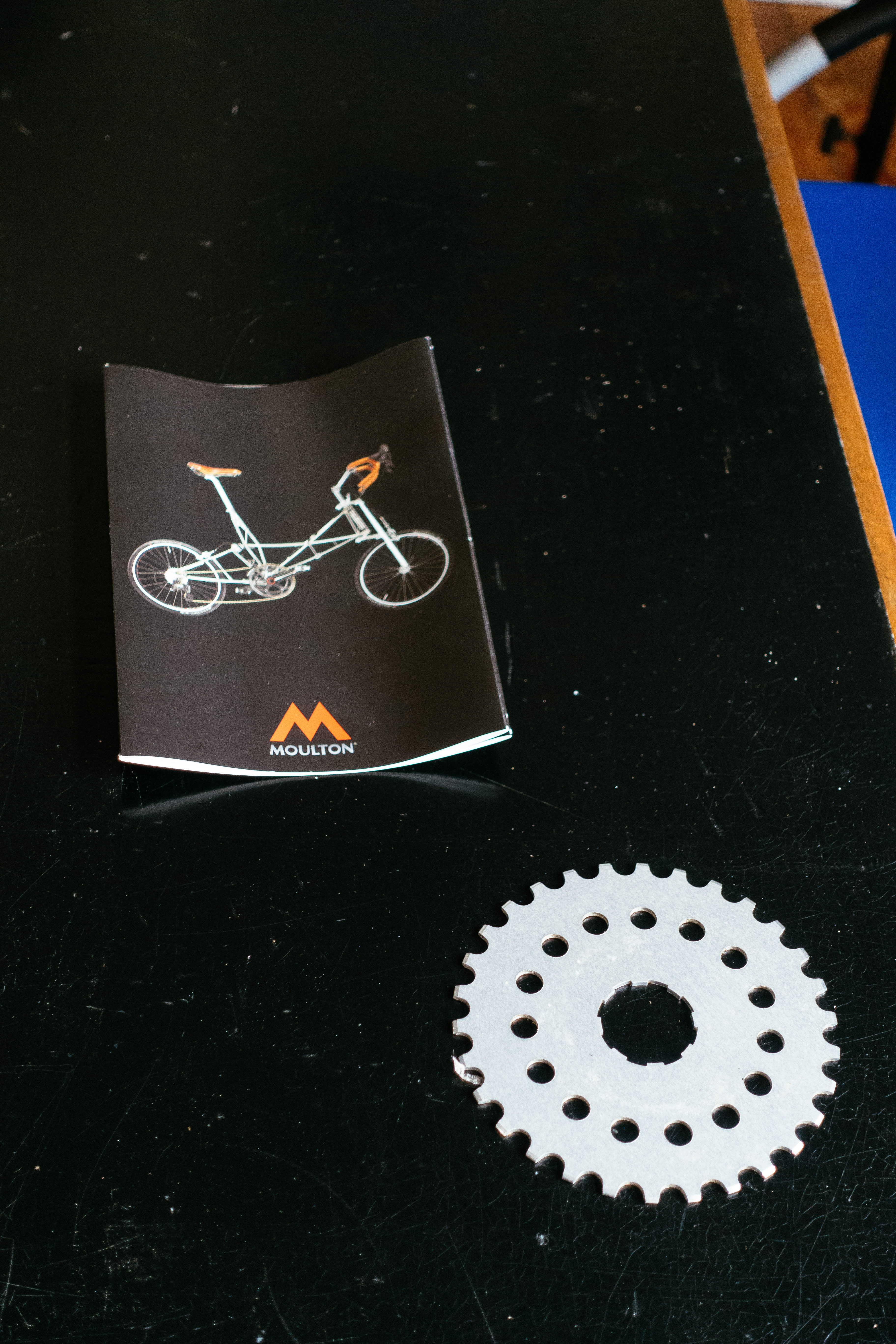
I'm not entirely sure what the sprocket is from. There's every chance it's from a truck rather than a bicycle, given the automotive paraphernalia in the office alongside the bicycle bits.

I suspect this cover of Japanese GQ was a little less faded in 2009.
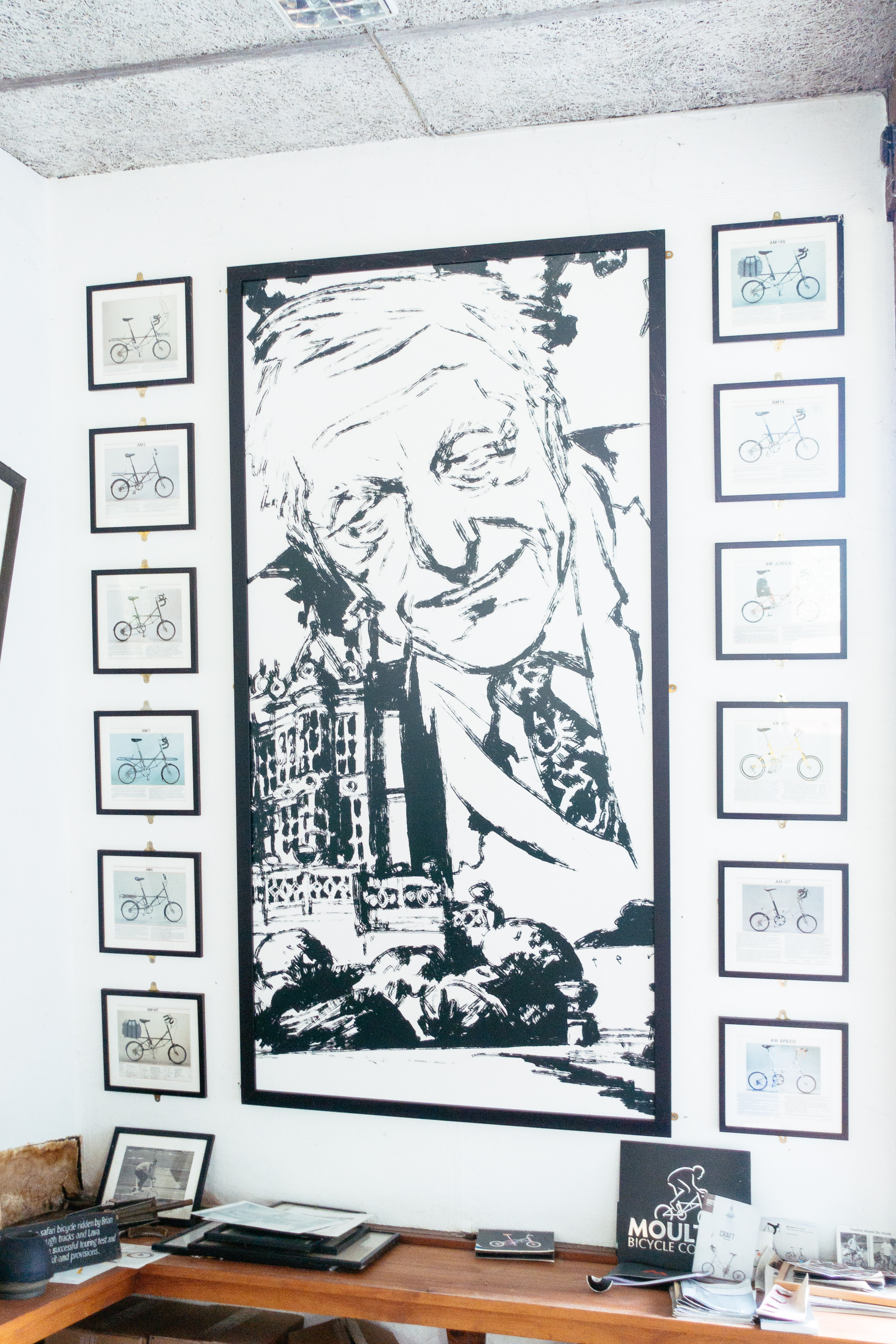
Alex Moulton, the estate, and the Moulton models.
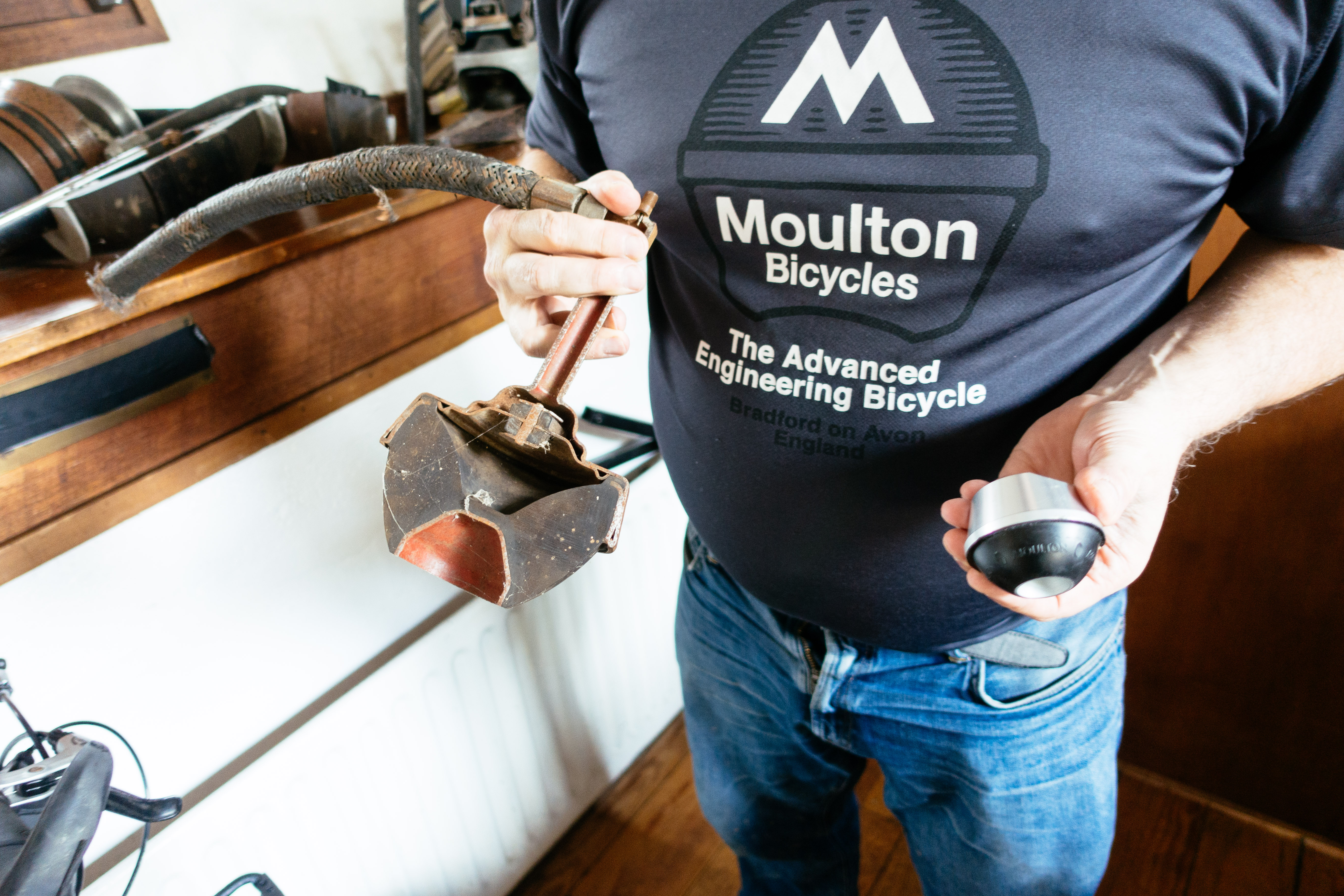
Steve shows me the suspension units from the Mini, effectively downsized to fit the Moultons of today.
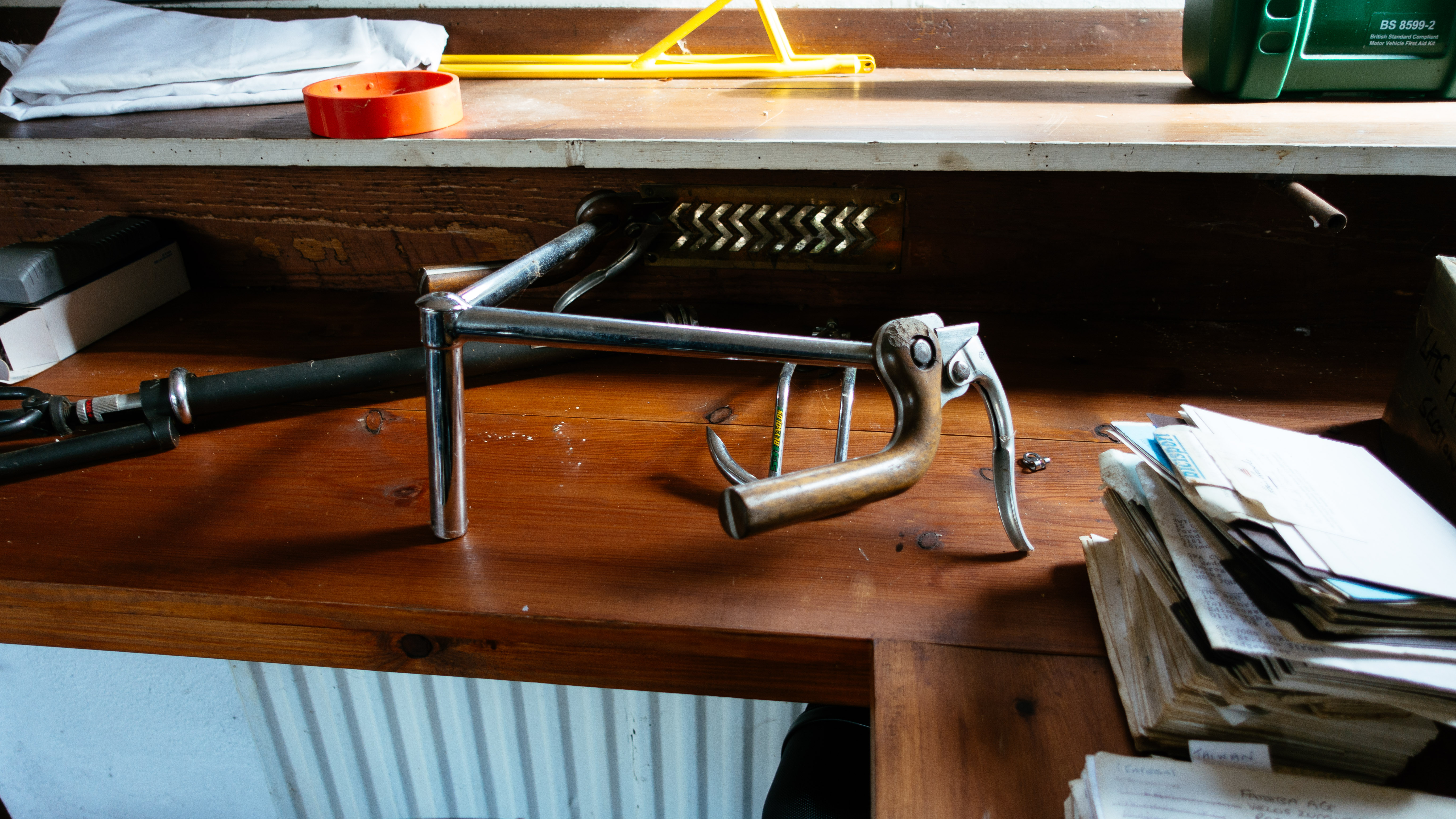
Some old prototype handlebars - Rarely is wood ever used in the industry anymore, even here, though I have once seen a wooden-rimmed Moulton.
Now the factory, as much as a production unit within the grounds of what, by rights, could very well be a National Trust property can be called a ‘factory’, produces models that range from the entry-level TSR, pitched at leisure cyclists and canal towpath botherers, through to the fully stainless NS Double Pylon, where even the head tube and seat tube are trussed space frames rather than whole tubes.
My entry to the factory was charmingly low-key. Given the fact the factory is within a walled estate I was ushered through a gate in a wall up a side road, which made me feel more like I’d accidentally kicked my ball into a neighbour's garden than a visitor to a production plant. We then rode through the grounds on an entirely moss-covered ribbon of tarmac, rutted by time and corrugated by endless tree roots - certainly a test for the suspension - into the lower half of the estate. Here, a series of low buildings house the offices, paint shop, and factory floor.
The office, where I’m treated to an instant coffee and an extremely large slice of millionaire shortbread, is brimming with accumulated trinkets, trophies, design snippets, photographs and memorabilia. Frames covers of Japanese GQ lie next to bisected models of pneumatic suspension units, and dominating one wall is a giant monochrome portrait of Alex Moulton himself, flanked on either side by framed photos of Moulton models.
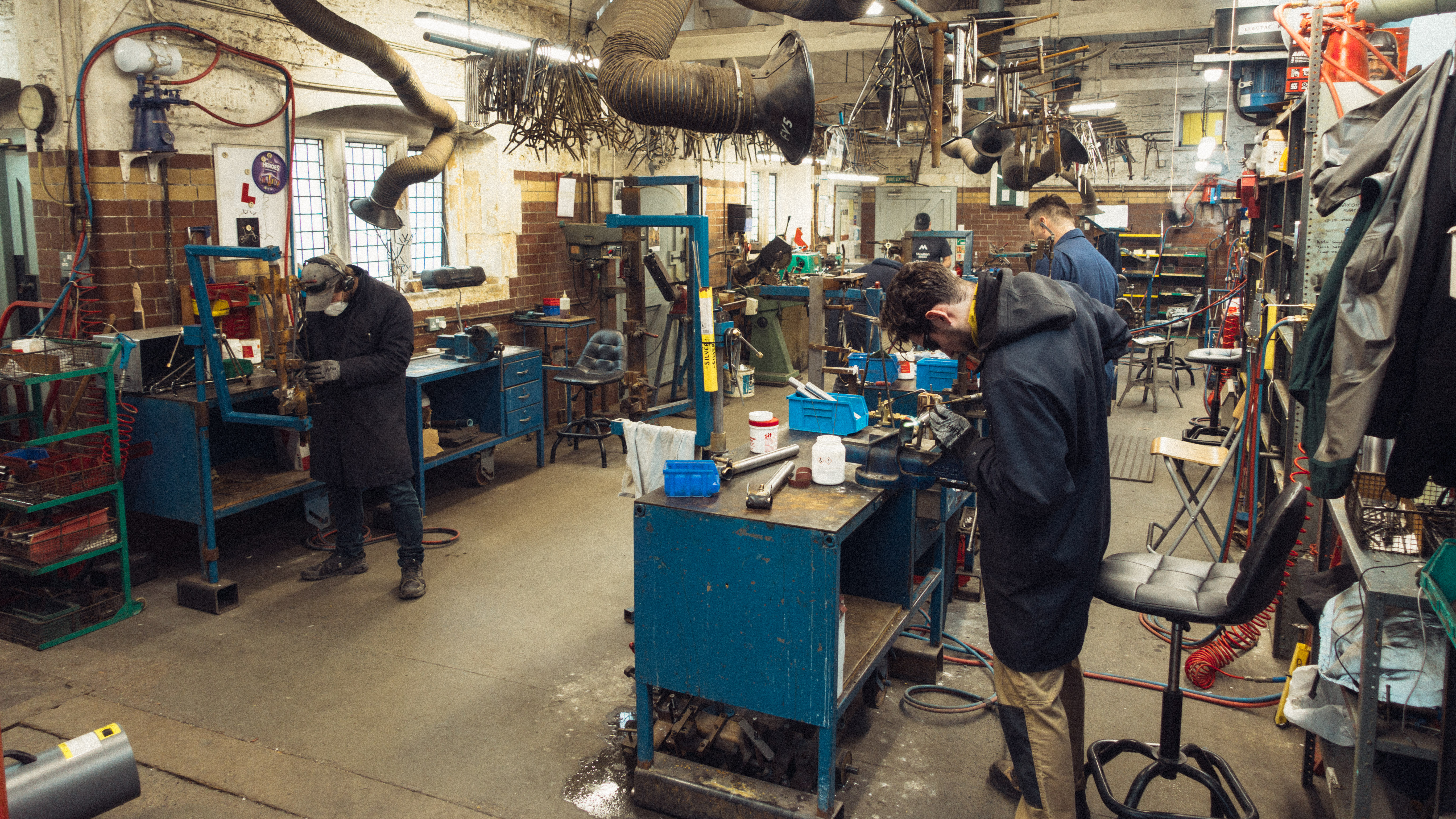
In the main workshop the men braze, file, and fit up various sub-assemblies.

There's a sense that everything has its place, even if to the untrained eye finding something specific looks near impossible.
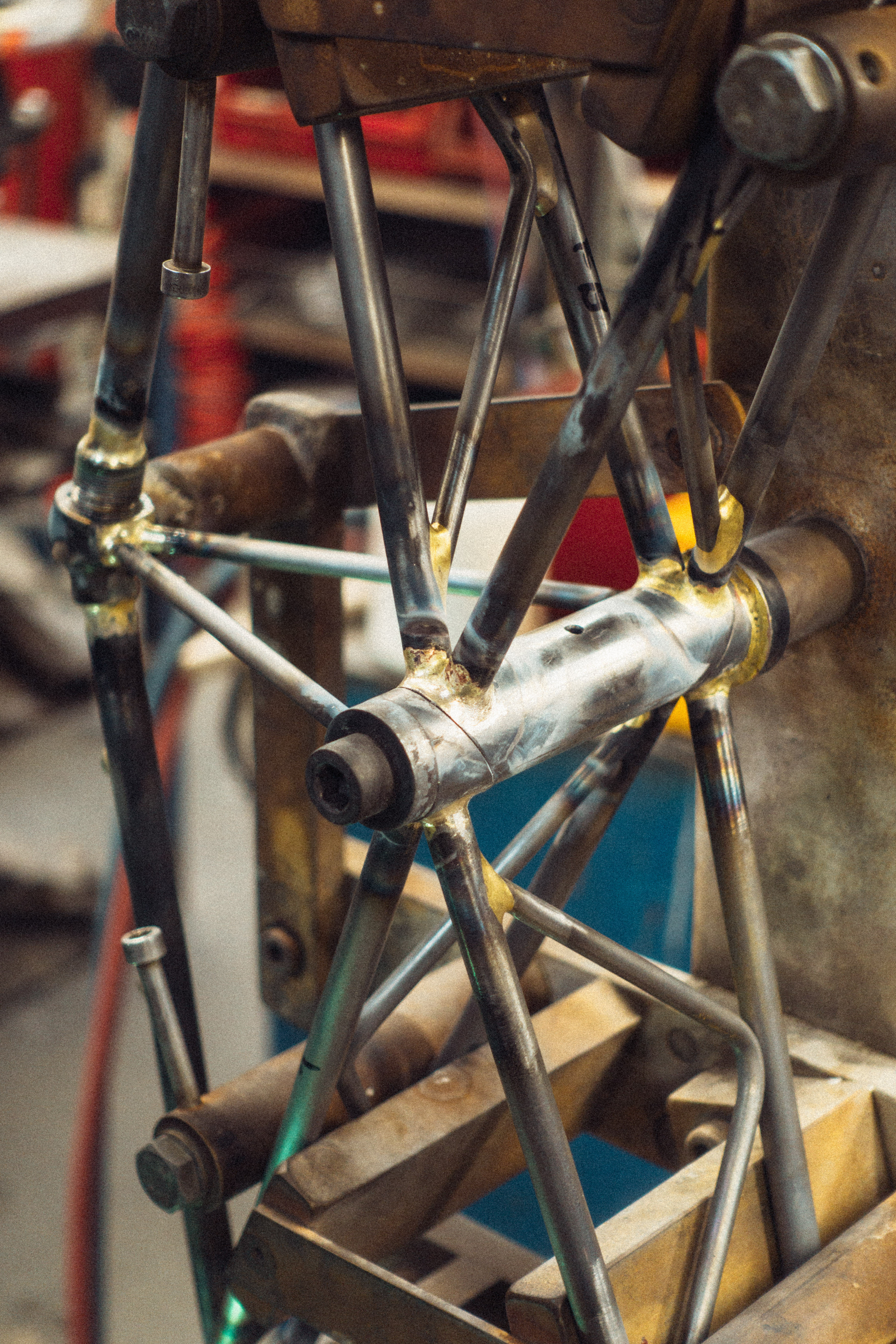
Compared to a standard brazed steel frame there are a fair few more brazes to complete here to create an entire bicycle.

The jigs are made in-house too, and have clearly been in use for some years.
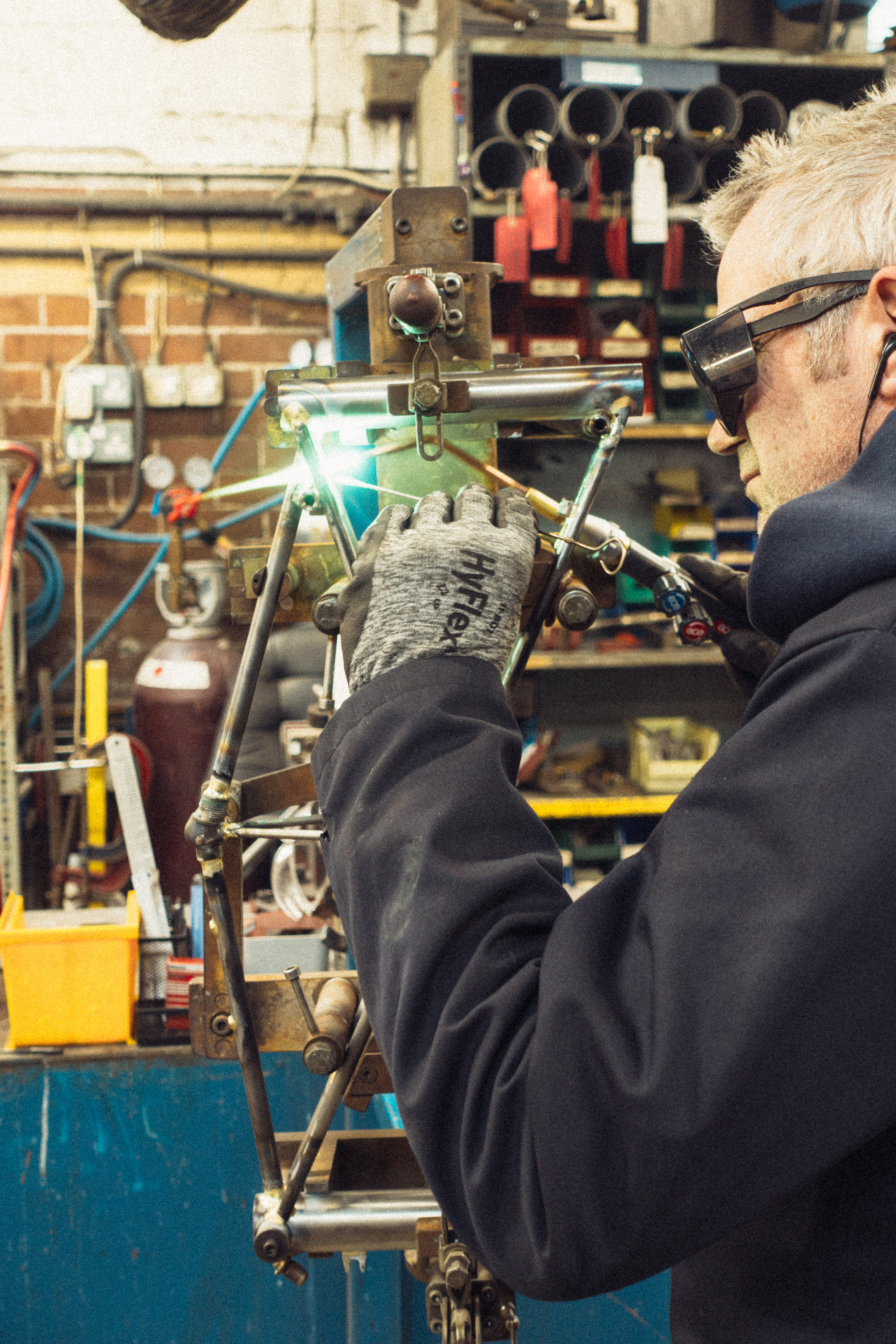
Unlike welding, which is noisy and flickering, brazing is serene, like slowly moving honey with a torch in near silence.
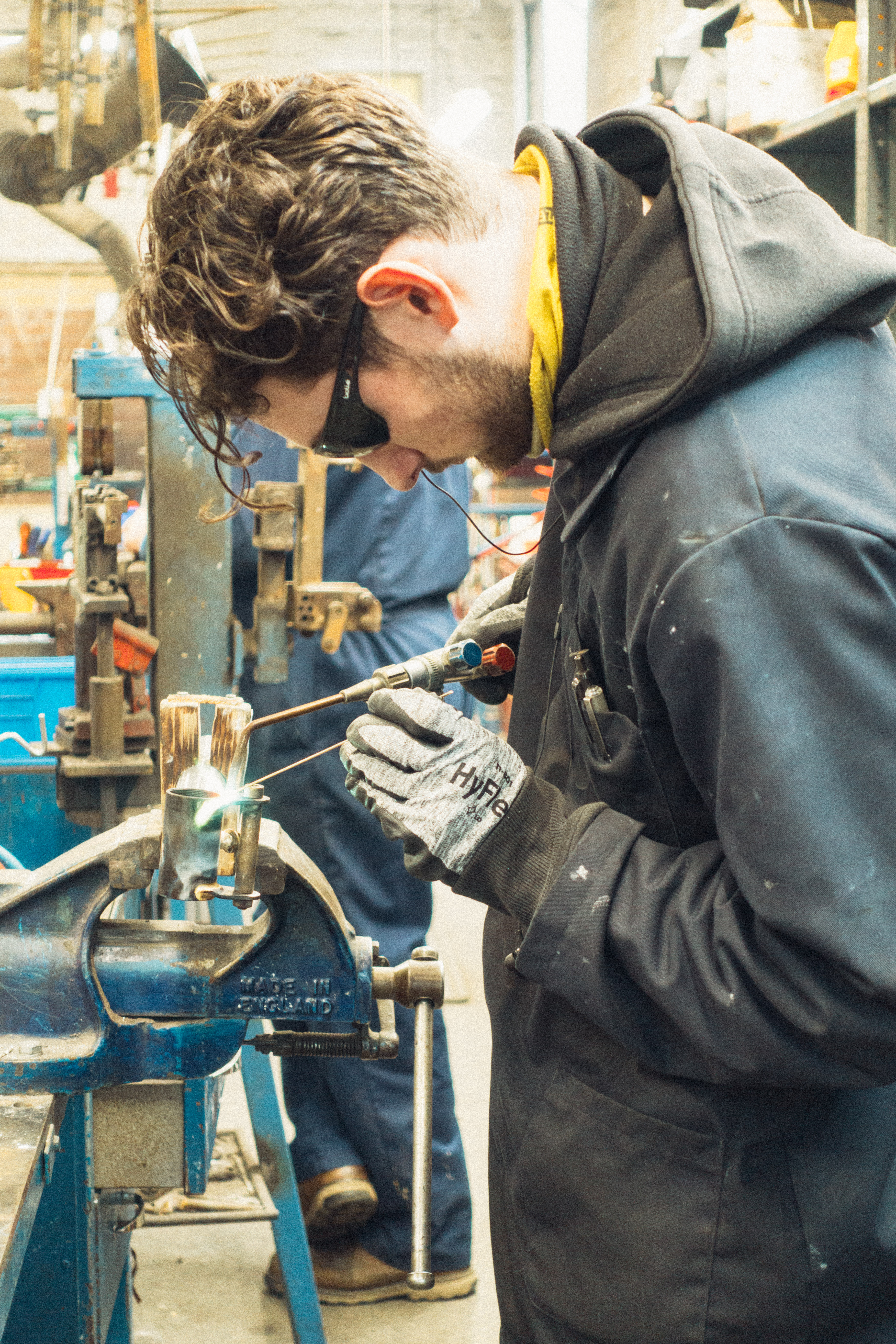
Here a bottom bracket assembly is being completed.
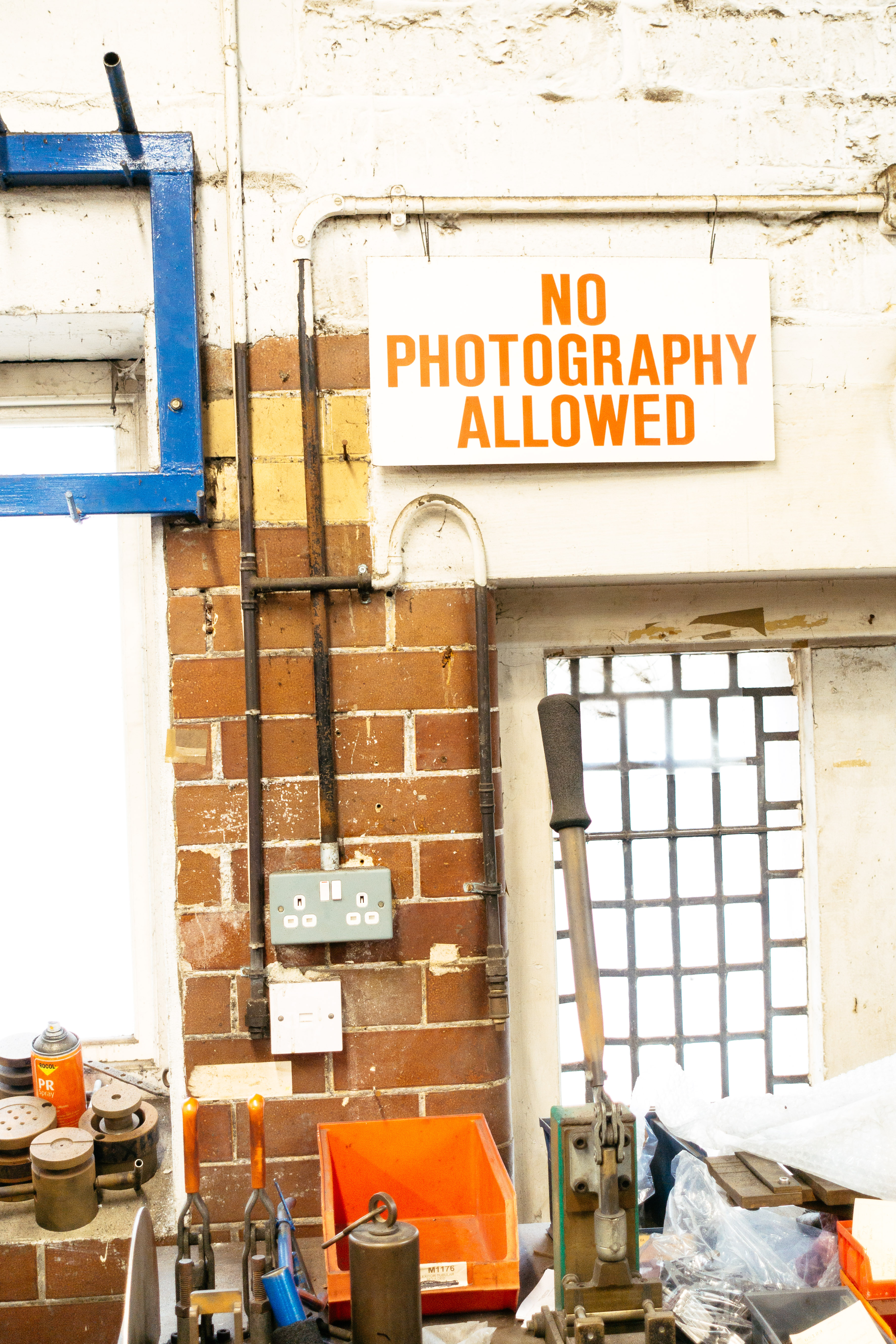
This sign won't stop me because I can't read.
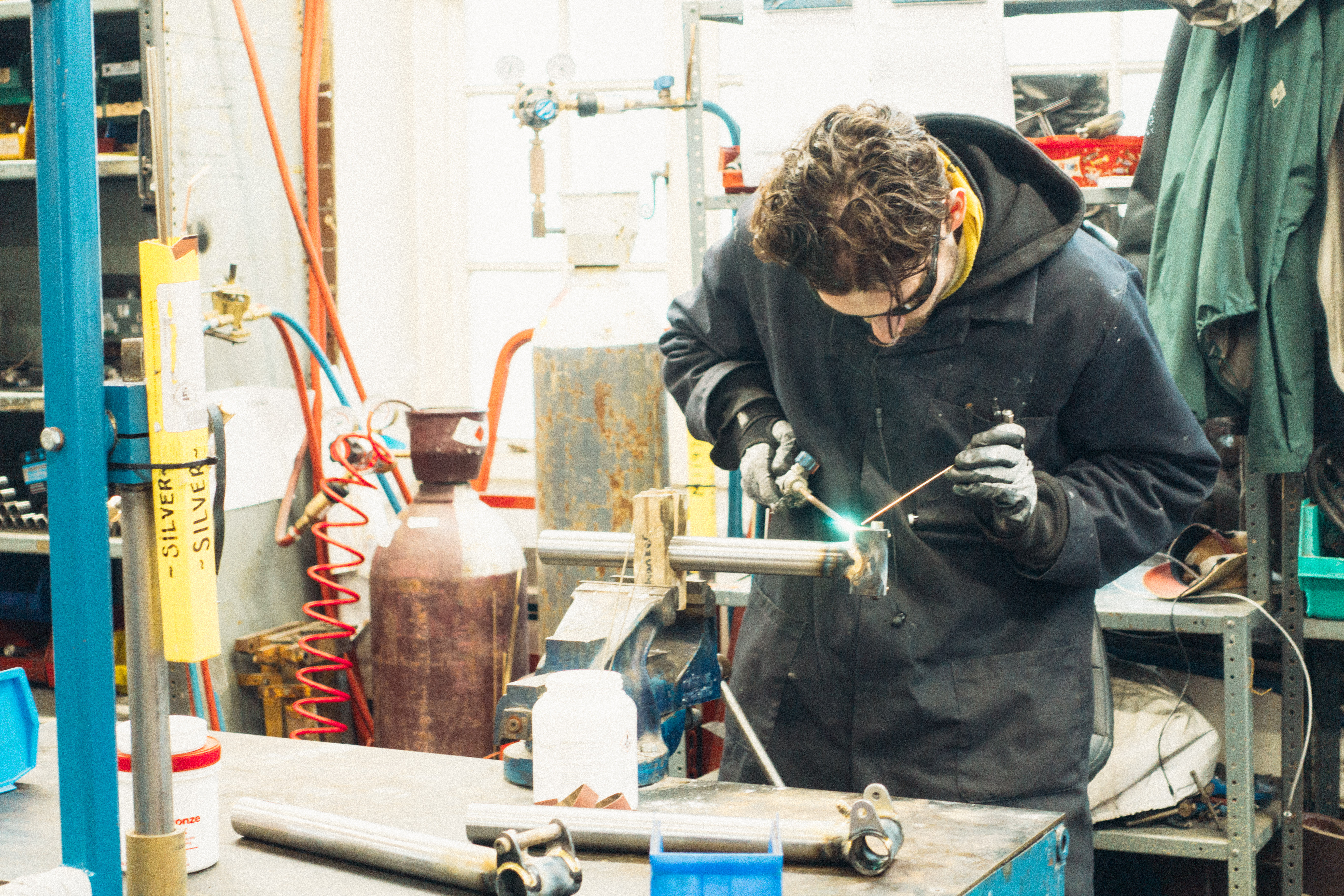
The brazers start on racks, and it can be six months before they graduate to frames.
The British have a wonderful obsession with the success of men in sheds. Passionate, dogged individuals making marvels by the light of oil lamps in cramped spaces that smell of a mix of lubricating oil and an undercurrent of metal and damp. Moulton, I’m very happy to say, fits my expectations.
While the Colnago paint shop in the outskirts of Pisa felt like going back to the 70’s, if I was told that the men beavering away with files and torches, brass and silver and flux, still operated in imperial measurements and were paid in shillings I’d be at least some way to believing. Only their headphones, cabled units snaking out of boiler suits, nodded to the modern age.
The brazers all start on racks, where there is a little more margin for error, before graduating to sub-assemblies of entire bicycles. Given the fact the bikes do not use the standard arrangement of head tube, down tube, seat tube etc, Moulton has had to make all its own jigs too, and as such each new model is created ‘in the air’, so to speak, before a jig is designed retrospectively to create subsequent models. In a smaller building - a little uphill next to the paint booth - a new jig is being designed for the new Moulton Safari model.
This British heritage, and slight misty-eyed nostalgia for the good old days, may be waning here, but it’s certainly popular in Asia. Moulton sells very few models domestically, with the overwhelming majority shipping to Asia. I’m told the markets fluctuate, with perhaps Japan dominating for some years before waning, and the slack picked up by Thailand, Indonesia, or Korea. Nations with a far greater love of minivelo, or the small wheeled bicycles than we have here in the UK.
I have a feeling the success of the brand in Asia is in no small part down to Steve.
He’s clearly a man who has bought into the brand wholeheartedly and clearly loves his trips to visit his dealers in the East. As I mull over the day with a sad meal deal sandwich beneath a columned awning, Steve eats some spicy noodles from a mug. He tells me the lengths he goes to make sure his customers are happy, including flying to Brisbane to rescue a stuck seatpost.
As he finishes his lunch he tells me that he is so fond of this particular brand of noodles (MAMA, if you’re curious), that he often buys them in bulk in Thailand and uses them as packing material to ship bikes back to the UK. I’m afraid I hadn’t the heart to tell him that I can get the same ones in my local supermarket, especially as I was sent home with a pack by way of a souvenir.
- Don't miss: Behind the scenes at the Colnago factory
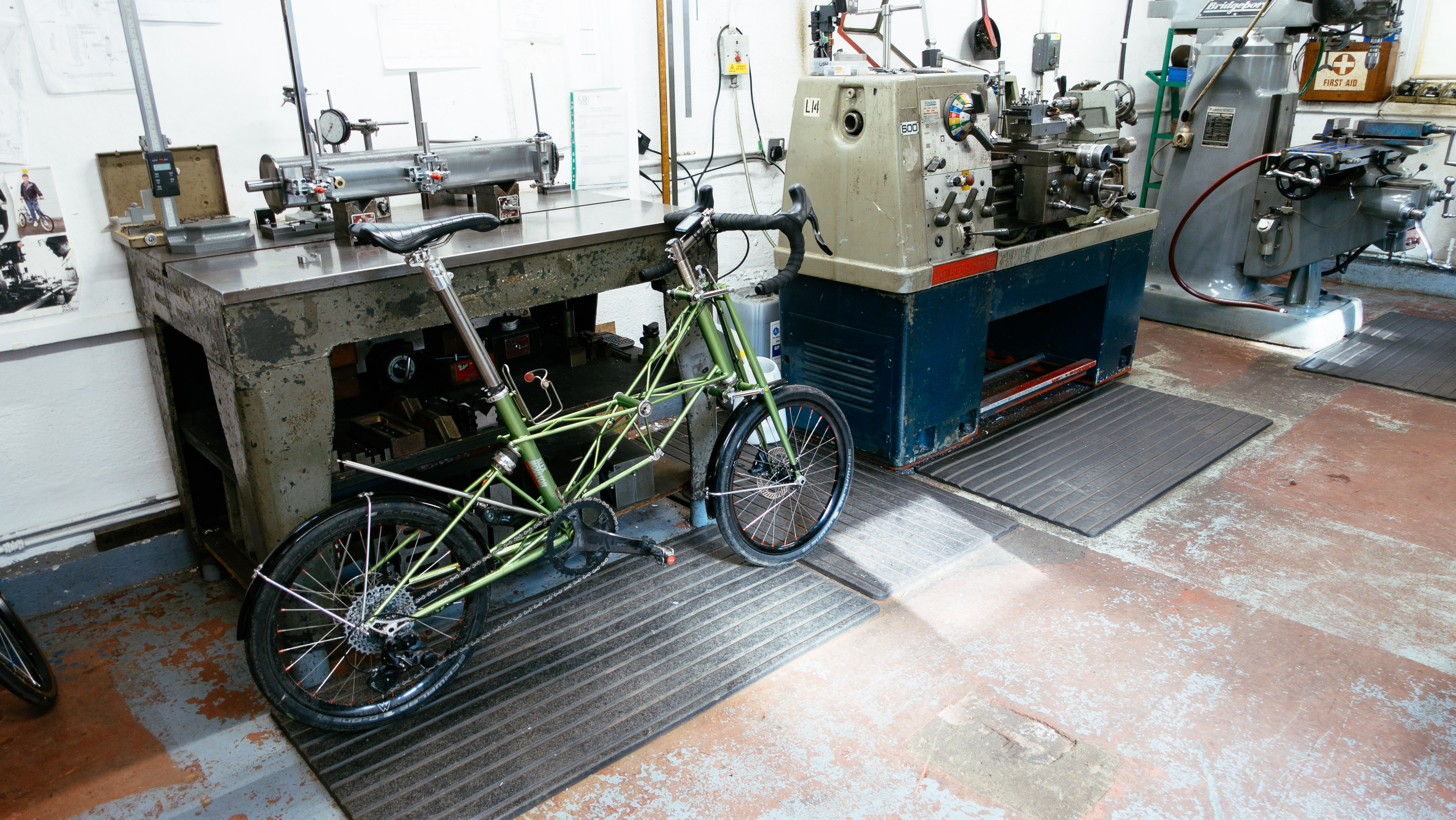
In a smaller workshop a new jig is being developed for the Moulton Safari, here leant against a surface plate used to check frame alignment.
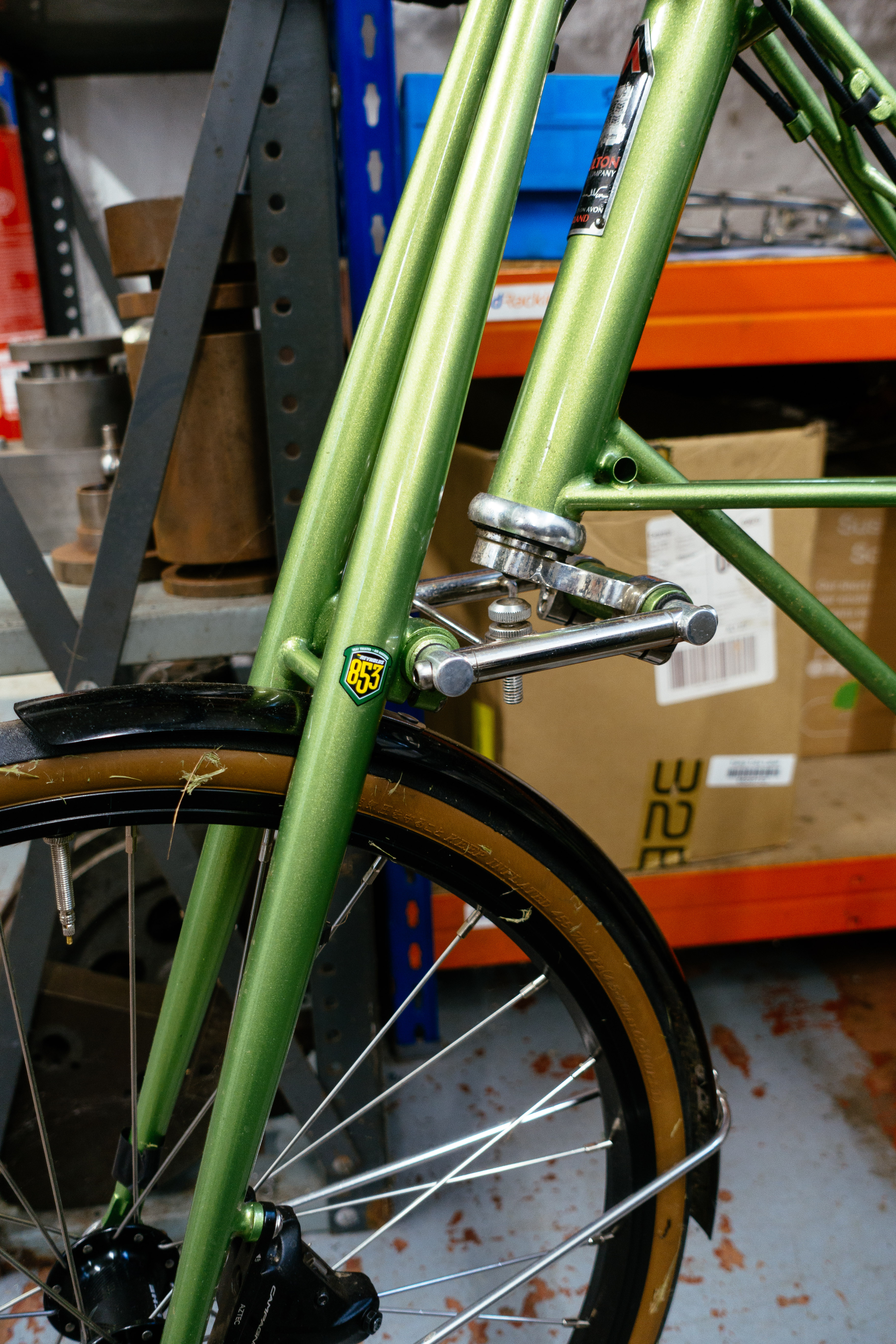
Most steel frames stick the tubeset badges on the seat tube, under the down tube, but Moultons have them on the fork legs.

'Willow green', I'm told, is the colour of this Safari model.
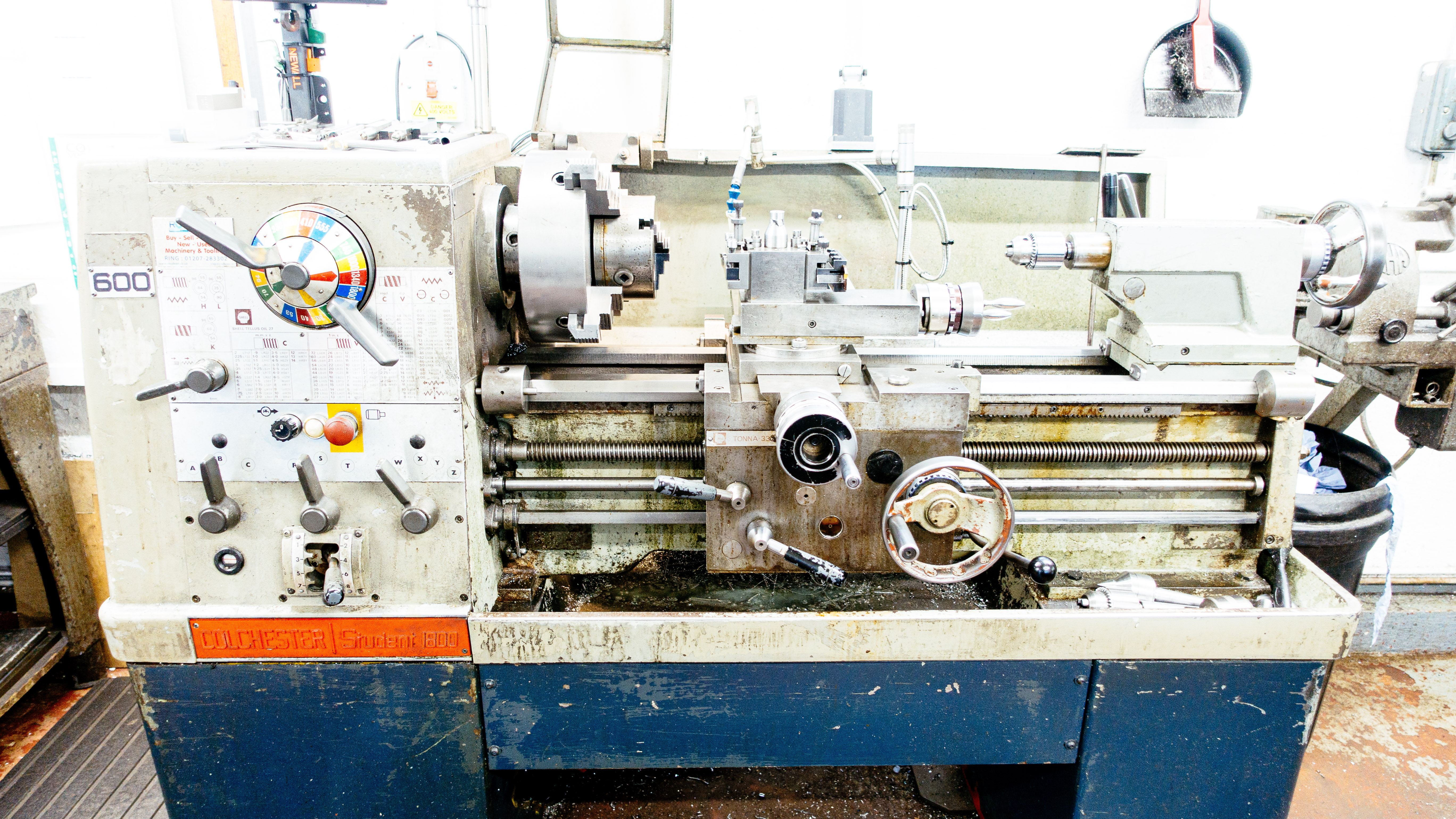
Given the number of things made in-house, a metal lathe is a must.

Considering I cannot keep a set of drill bits in order for more than a fortnight, this is astonishing.
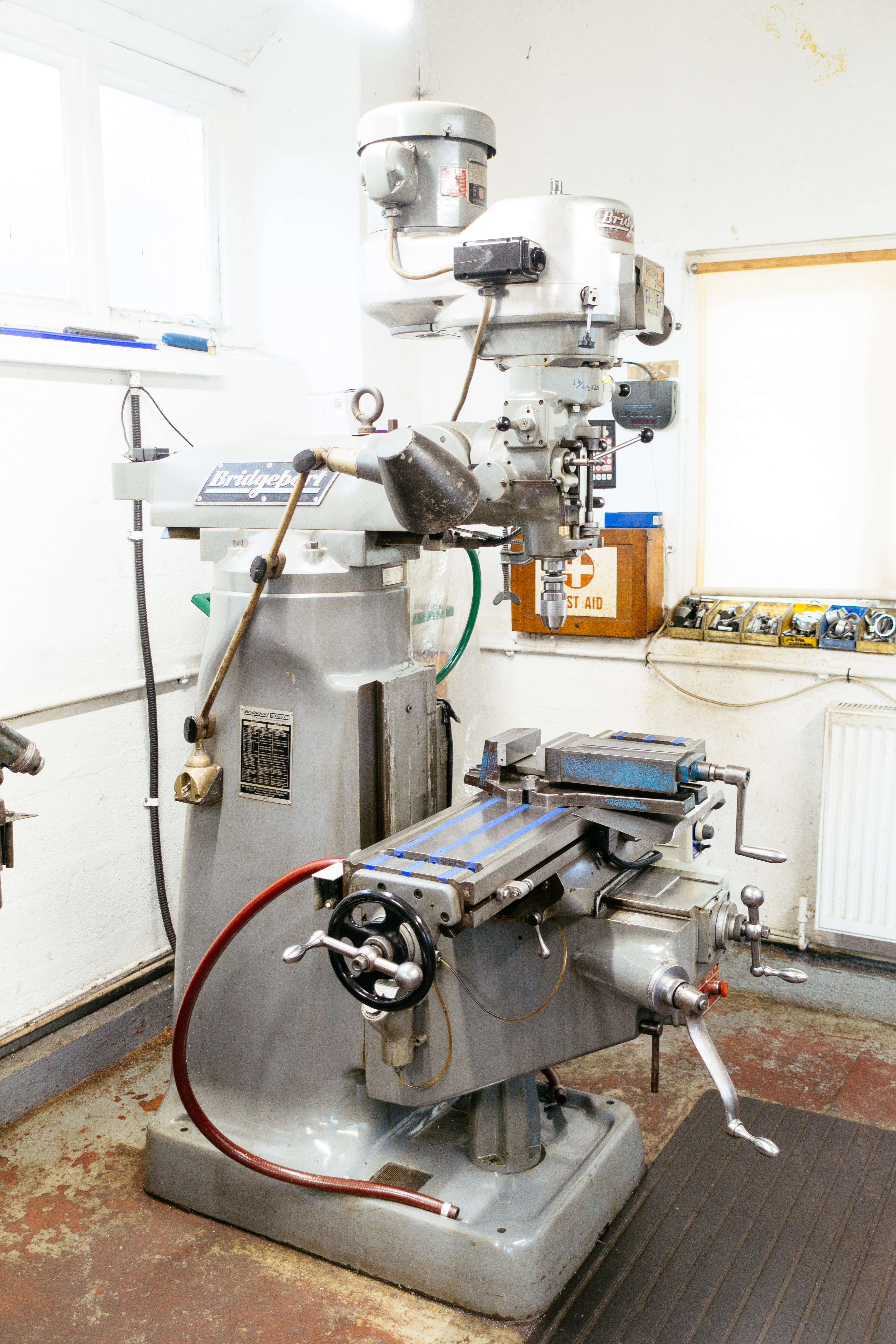
A vertical milling machine from Bridgeport is one of the newer machines in the workshop.
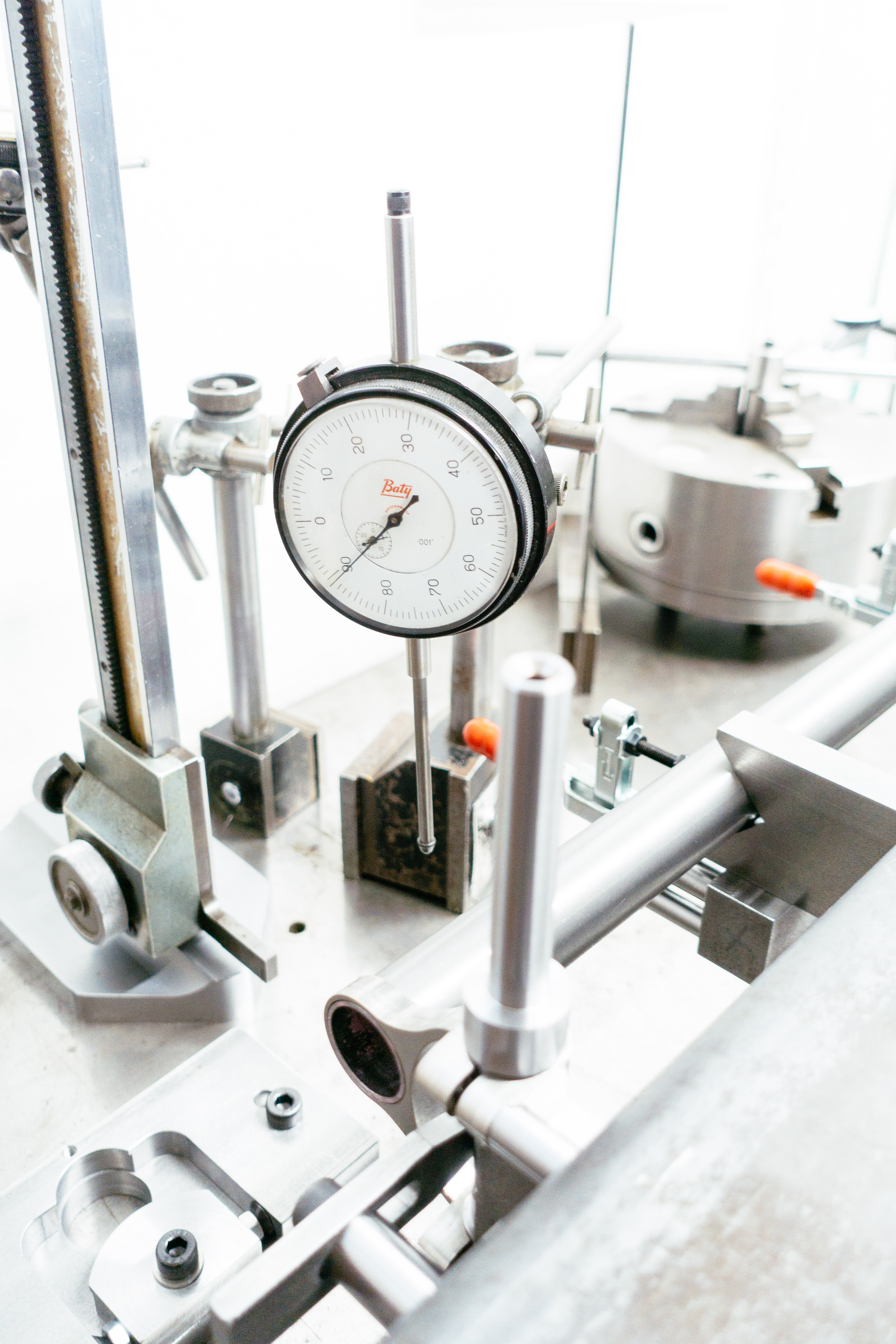
On the surface table, dials show if a frame is out of alignment
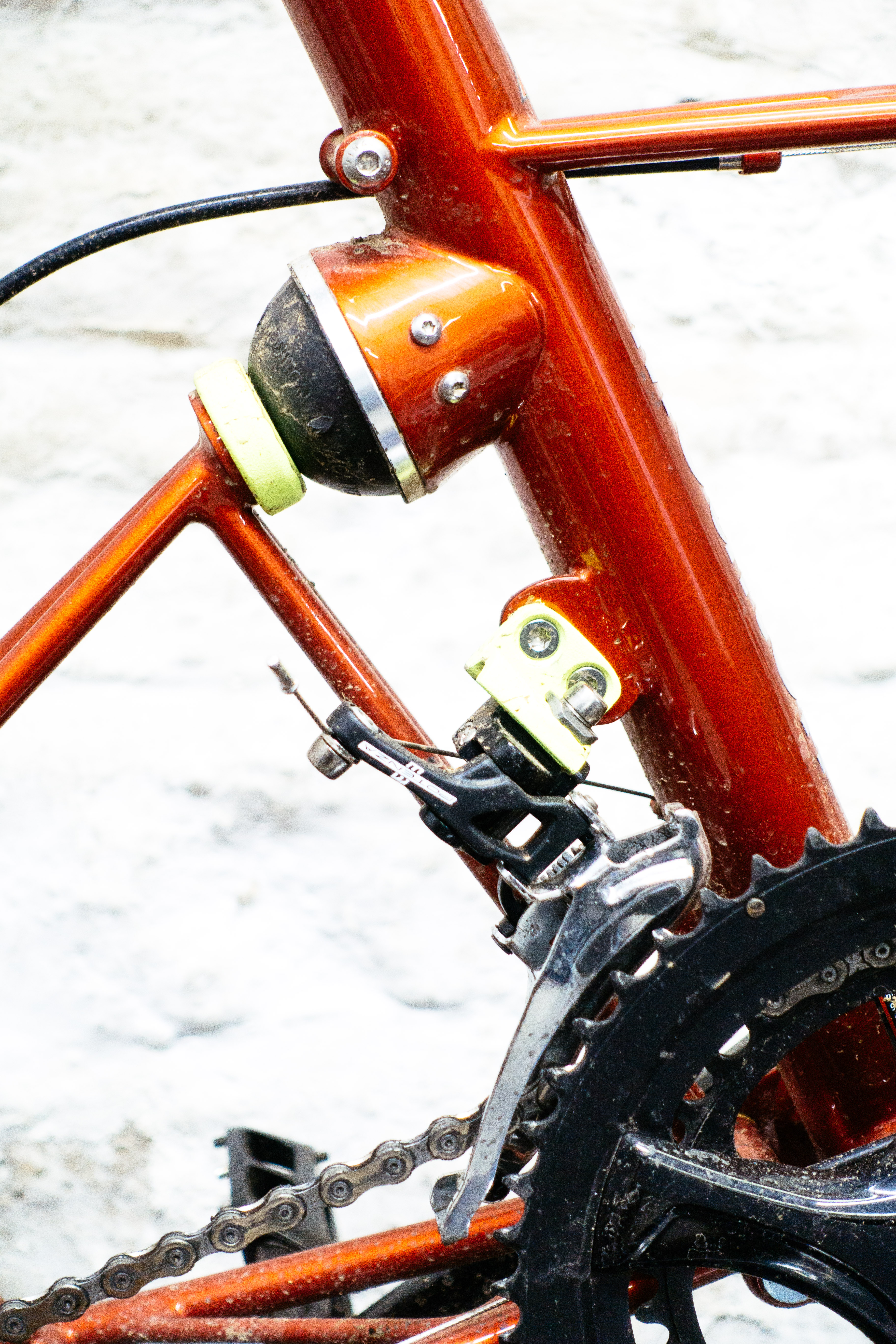
Here's a closer look at the rear suspension unit.
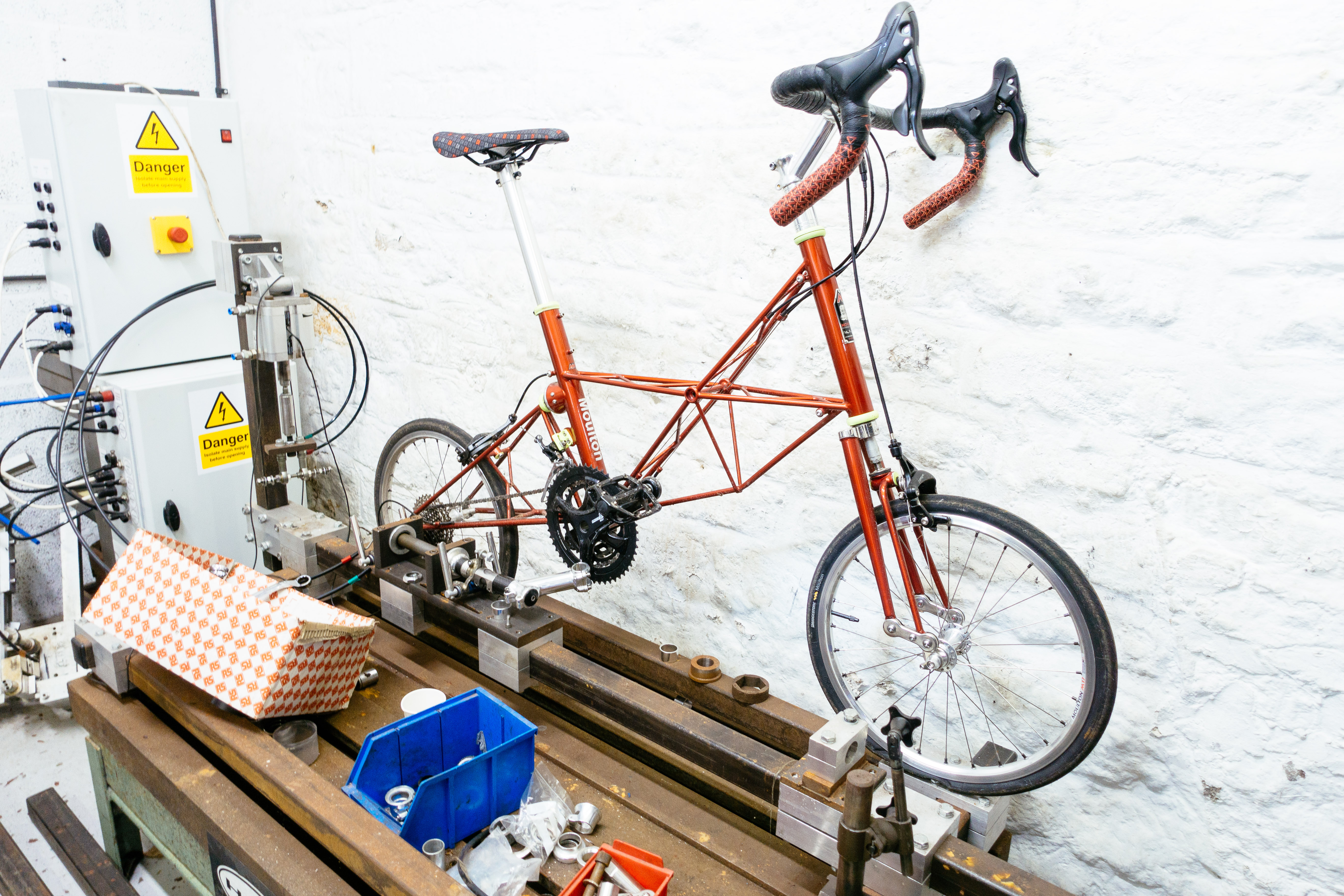
This is the first bike i've seen in the flesh that's running Campagnolo Potenza.
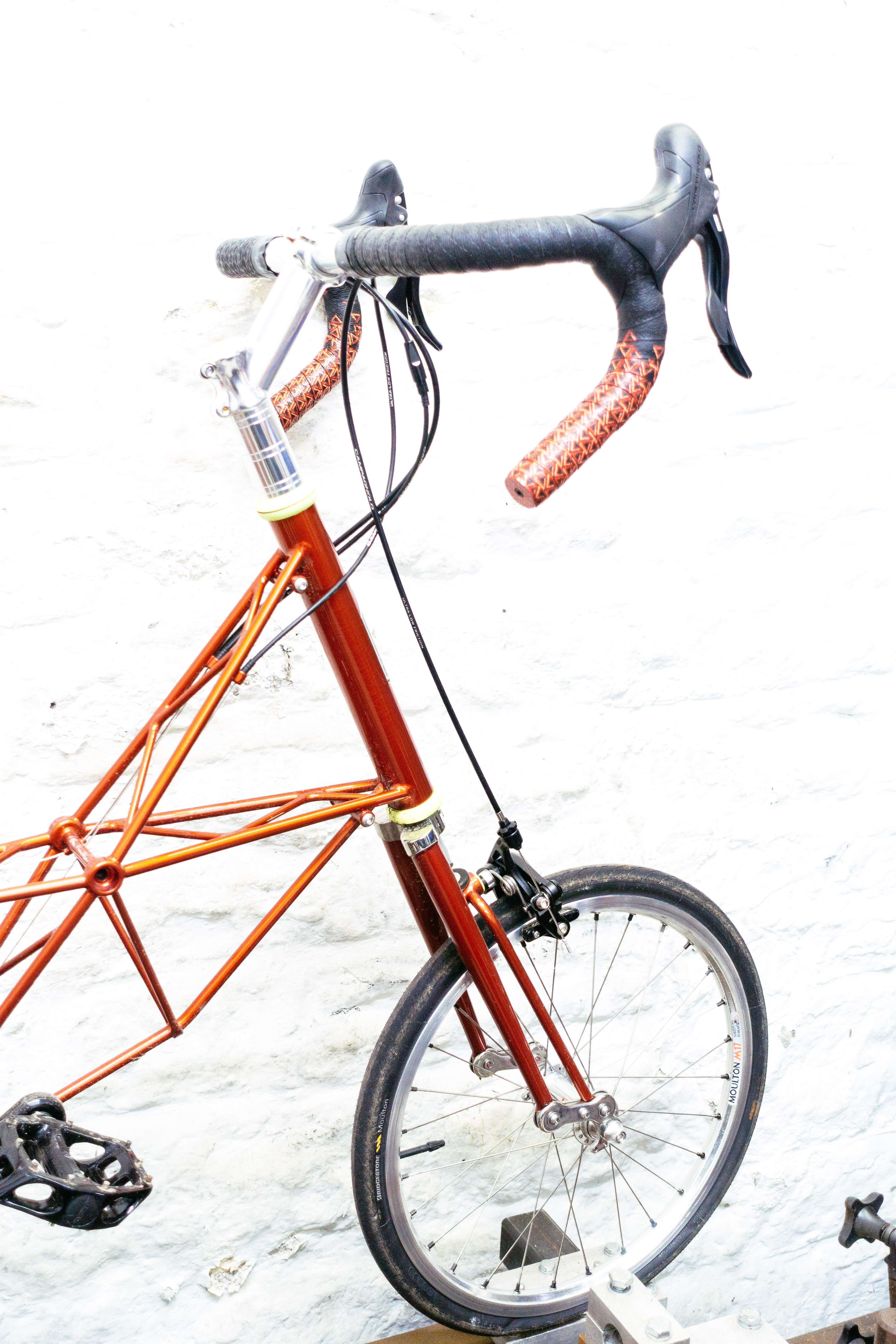
Given the unusual frame proportions a large stack of spacers and a positive rise stem are par for the course.
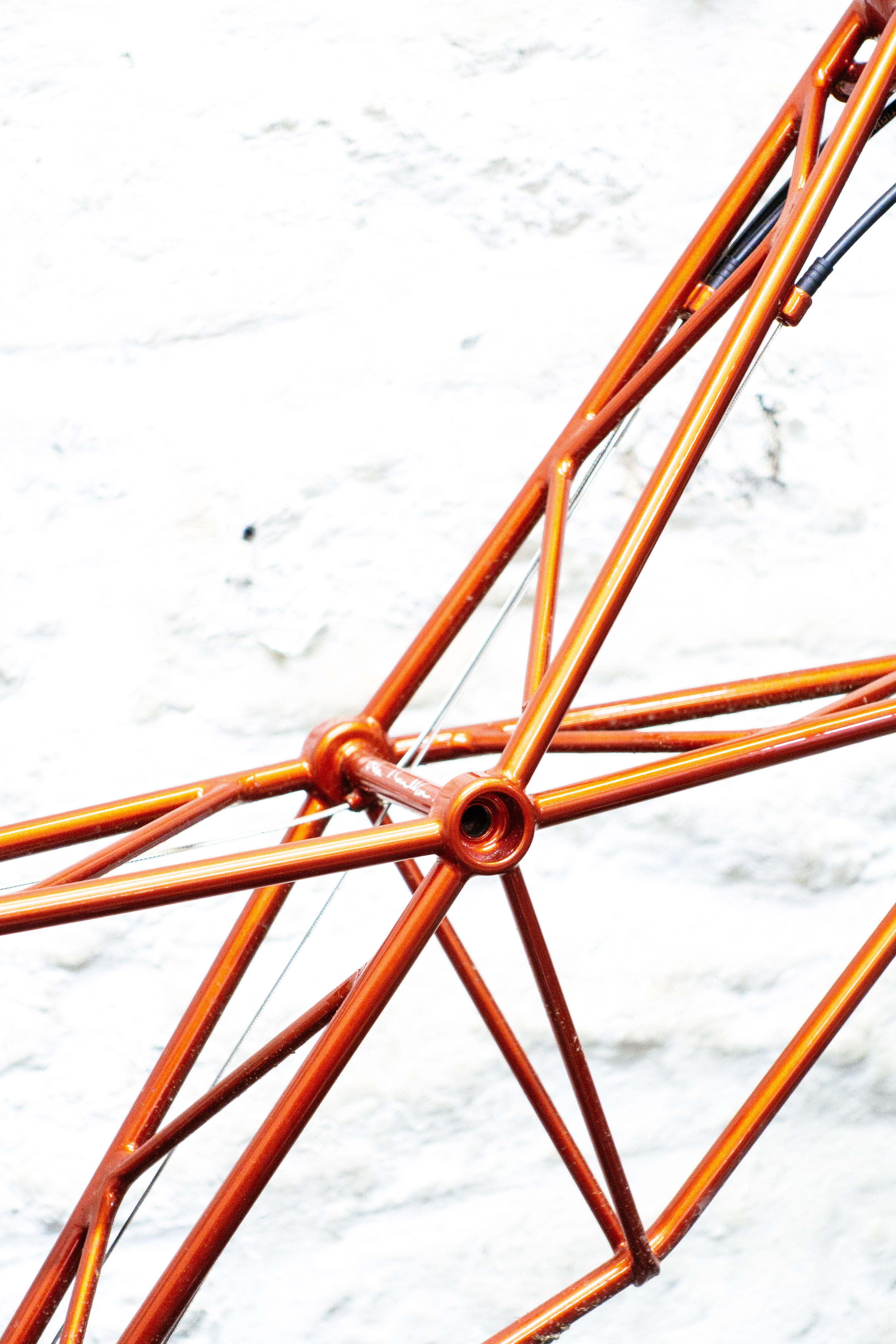
This central part of the spaceframe is usually where a Moulton would separate, but on this model it's fixed in place.
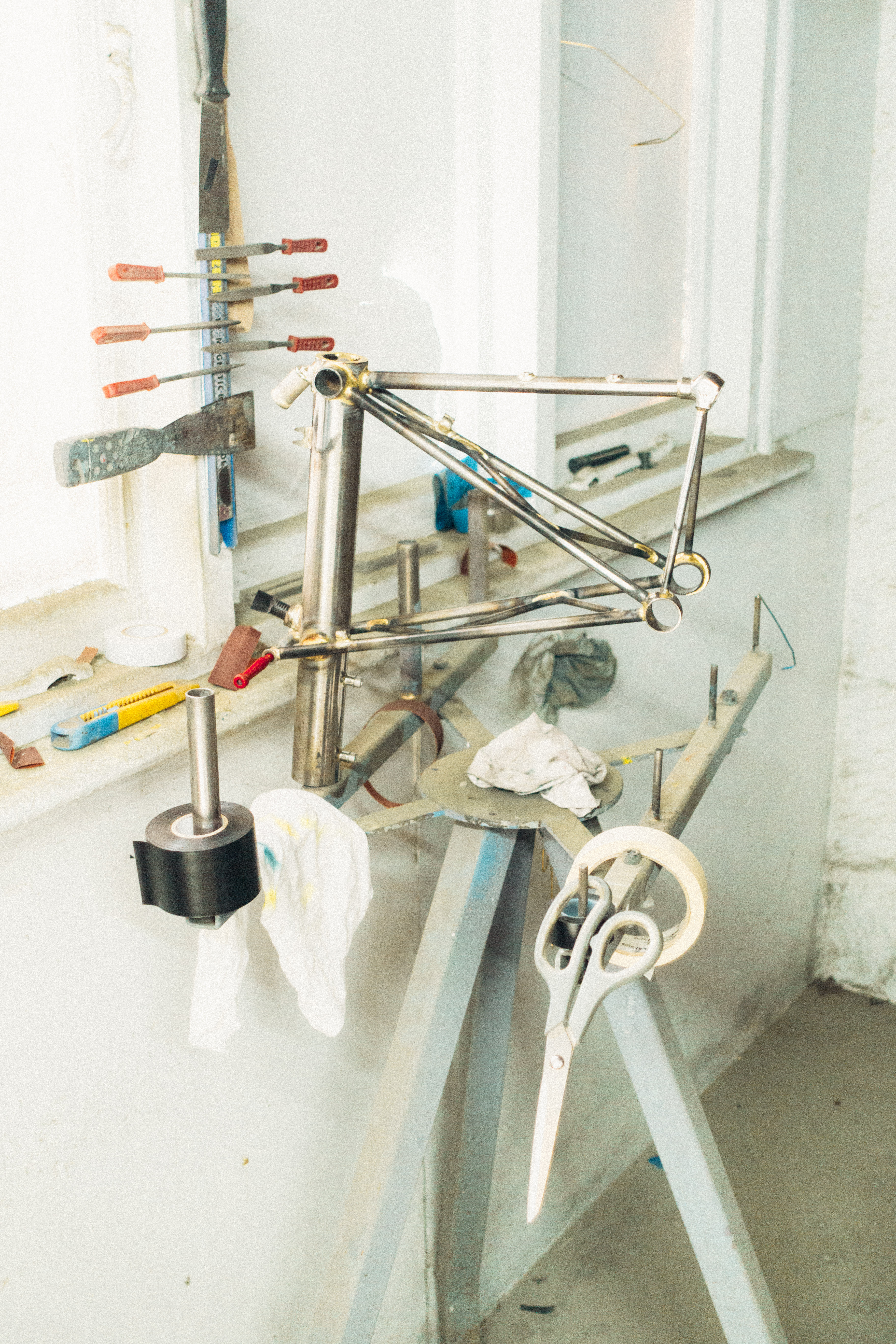
In the paint booth a rear end awaits a first coating.
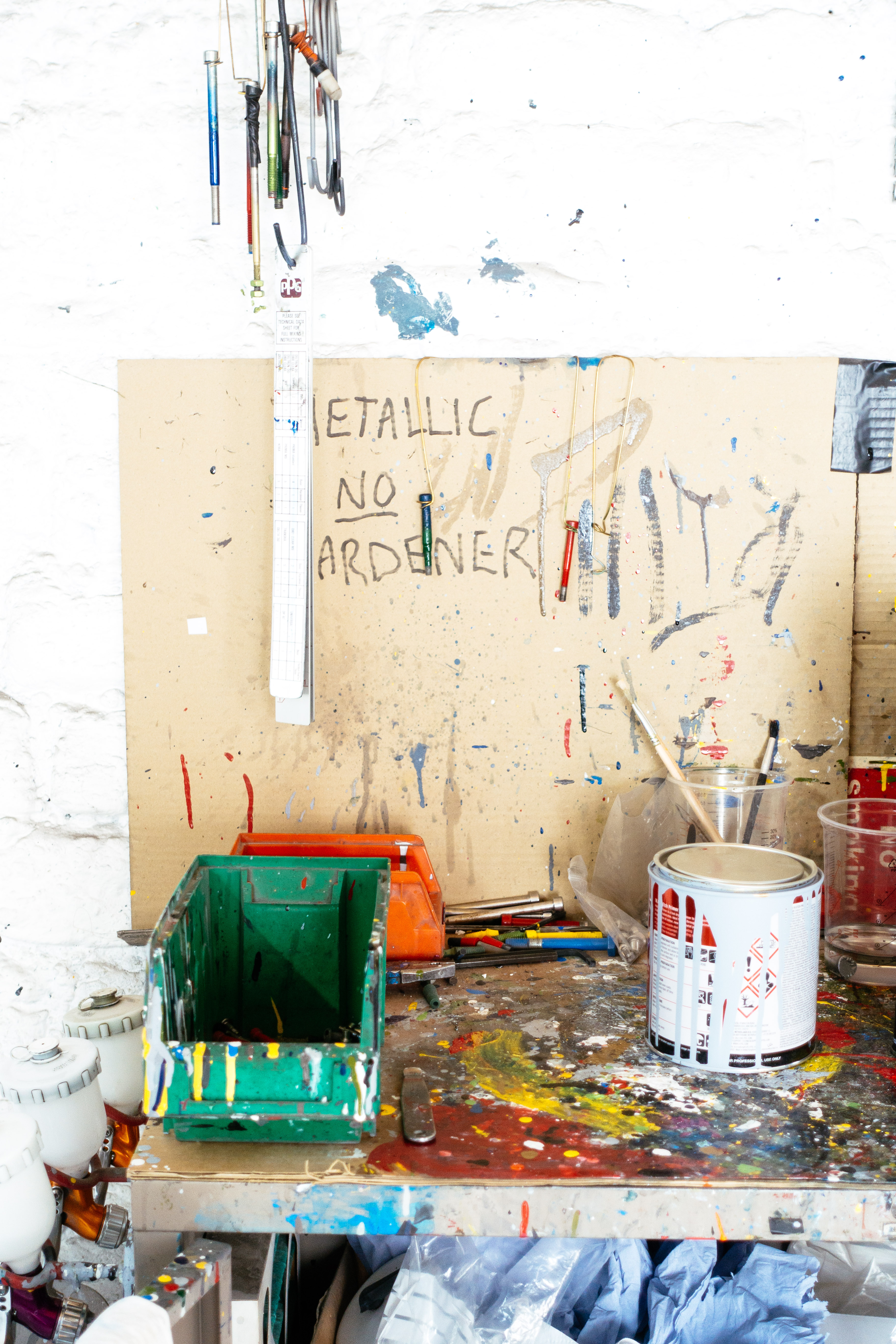
Paint booths are usually spotless, but paint prep areas, like this one, are often the opposite.
At the top of the estate there are the newer buildings, far more modern affairs with roofs that aren't sagging. Packing, polishing, building, and palletisation for shipping to Asia are all taken care of up here. It feels a world away from the brazing room below, though there are brazing stations up here too where less prestigious models are joined up.
In the lobby, awaiting a museum at some unspecified point in the future, is an agglomeration of historic models. There are the original shopping bikes through to models used in the Race Across America. Dura Ace downtube shifters mounted to handlebars butt up against rusty Sturmy Archer 3-speed levers.
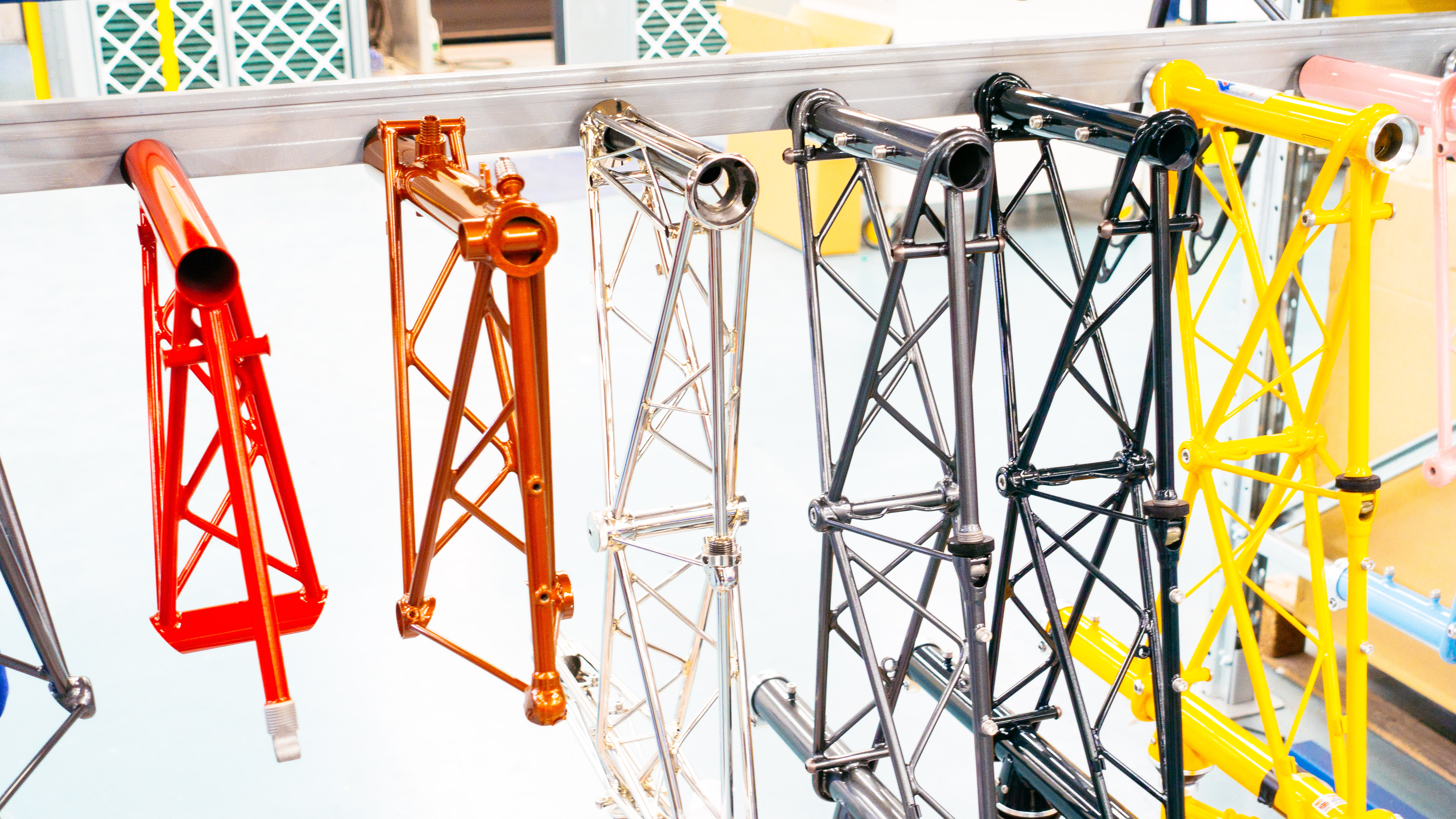
In the newer buildings at the top of the estate painted or polished frames are ready for assembly.

In the lobby a stack of old but significant models awaits a museum at an undetermined point in the future.
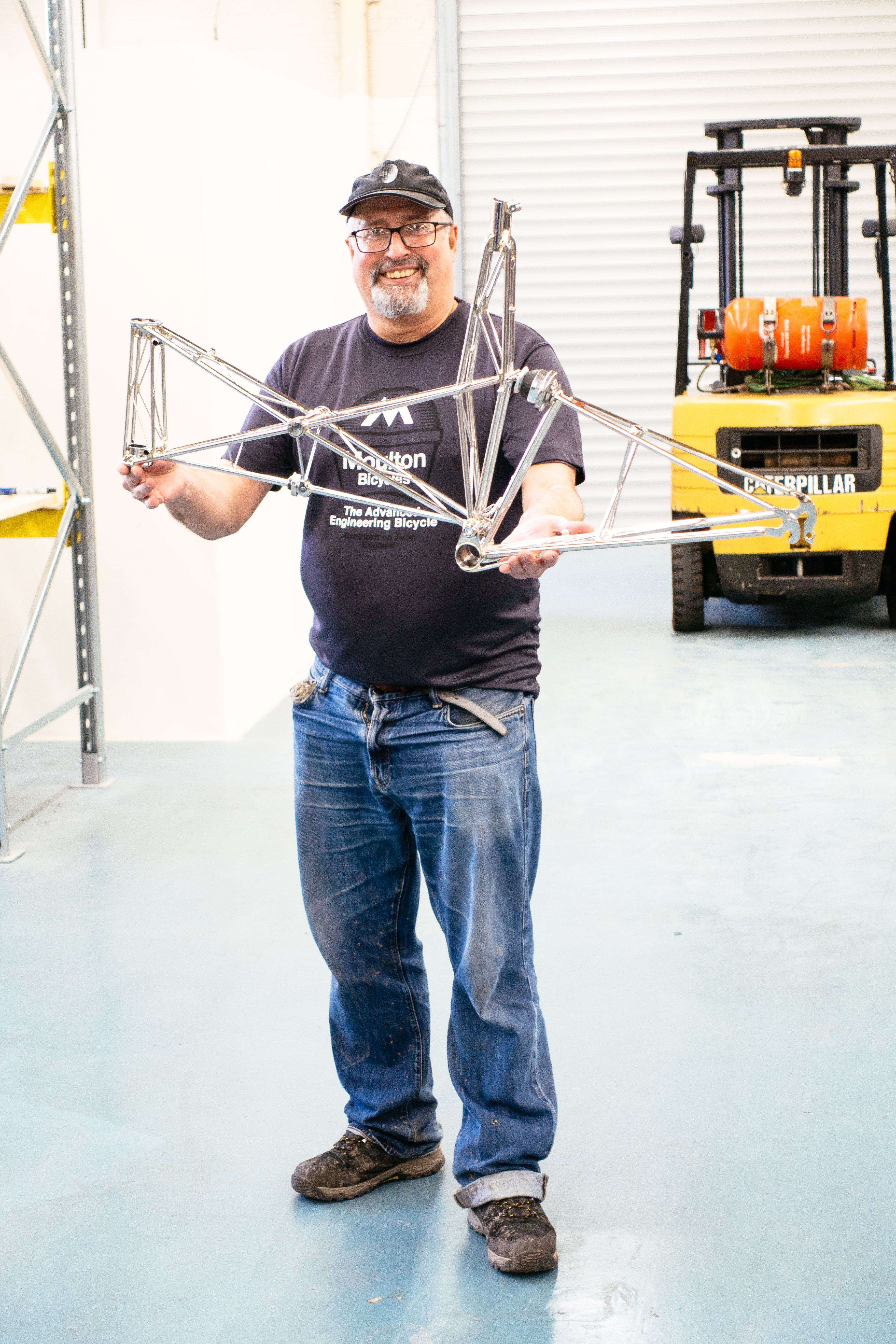
This is Steve. Cut him and he'd bleed Moulton. Here he's proudly showing off an absolutely top of the line NS (New Series) Double Pylon.
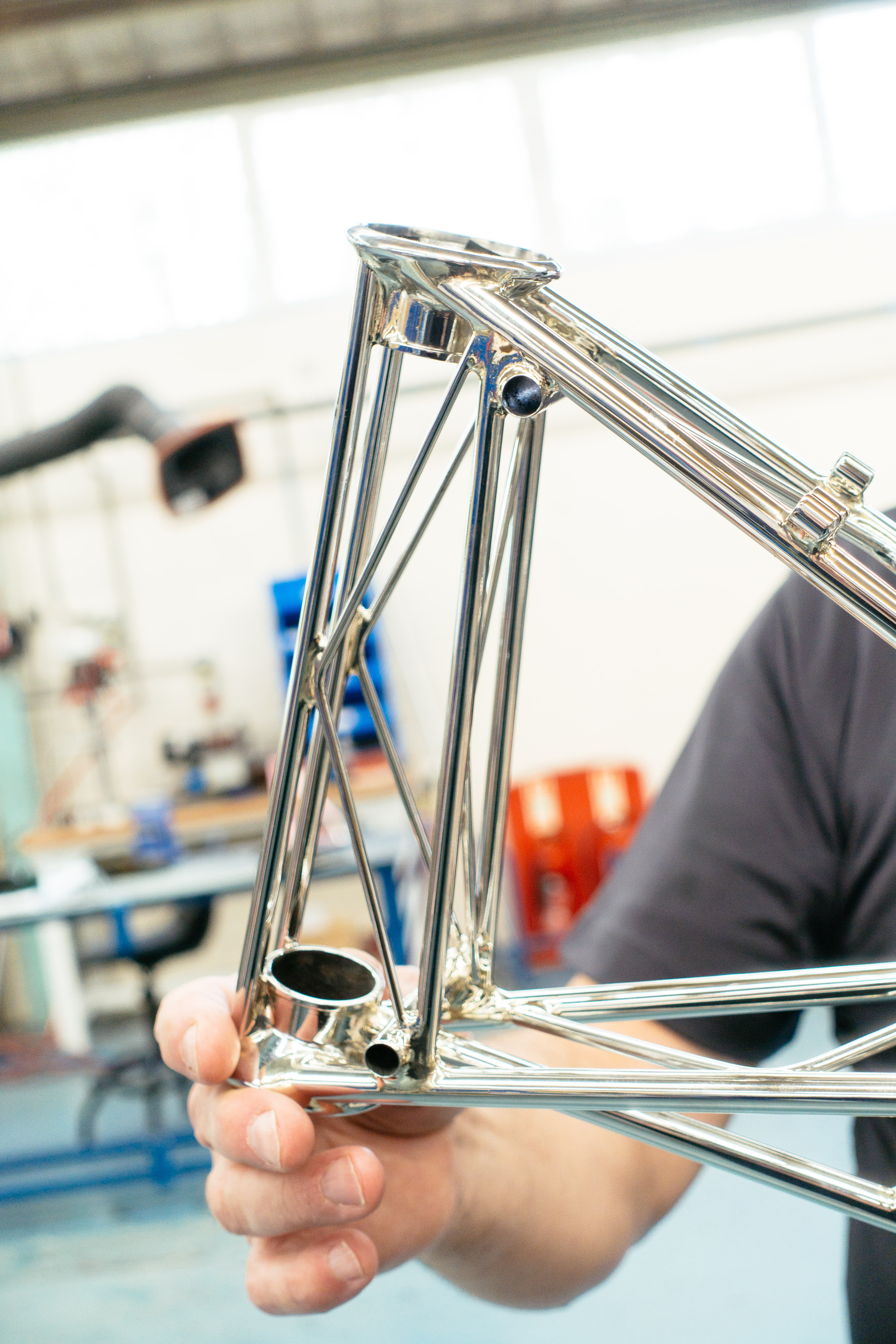
On the Double Pylon model even the head tube and seat tube assemblies are space frames.
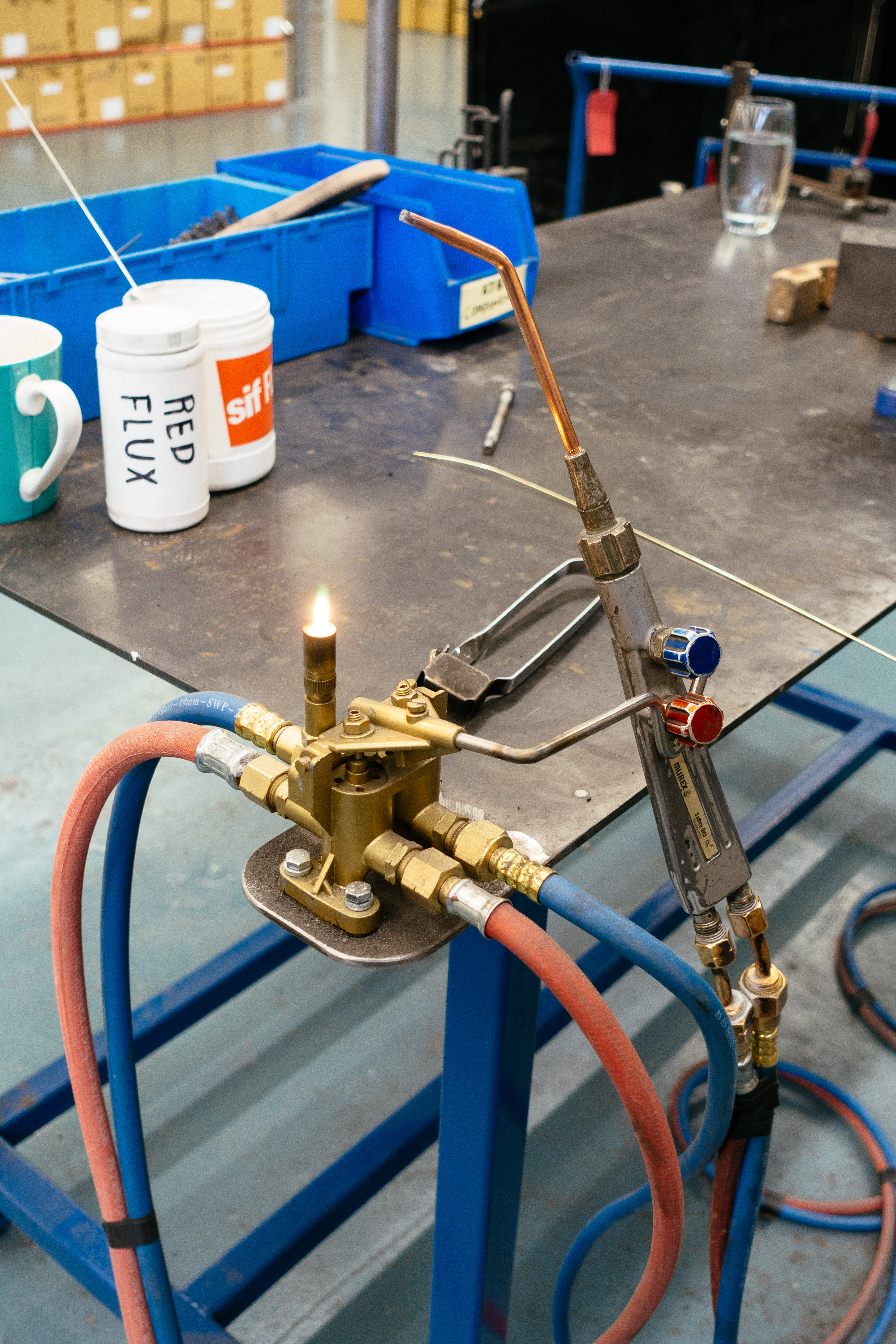
To save the brazers in the warehouse having to constantly strike their torches alight, a pilot light is constantly burning at each station.
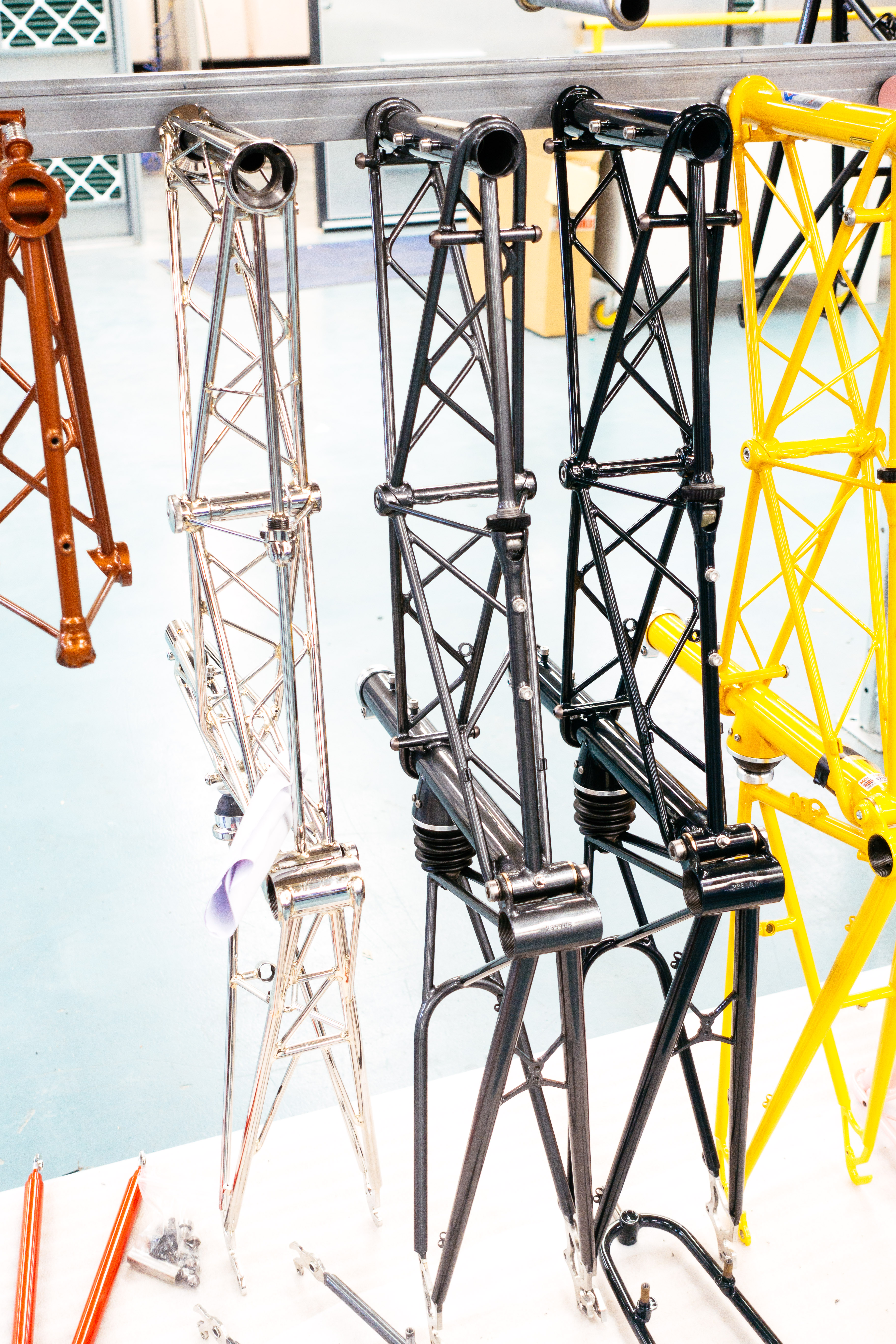
The off-road oriented XTB models are easily differentiated by the concertina rear suspension shrouds.
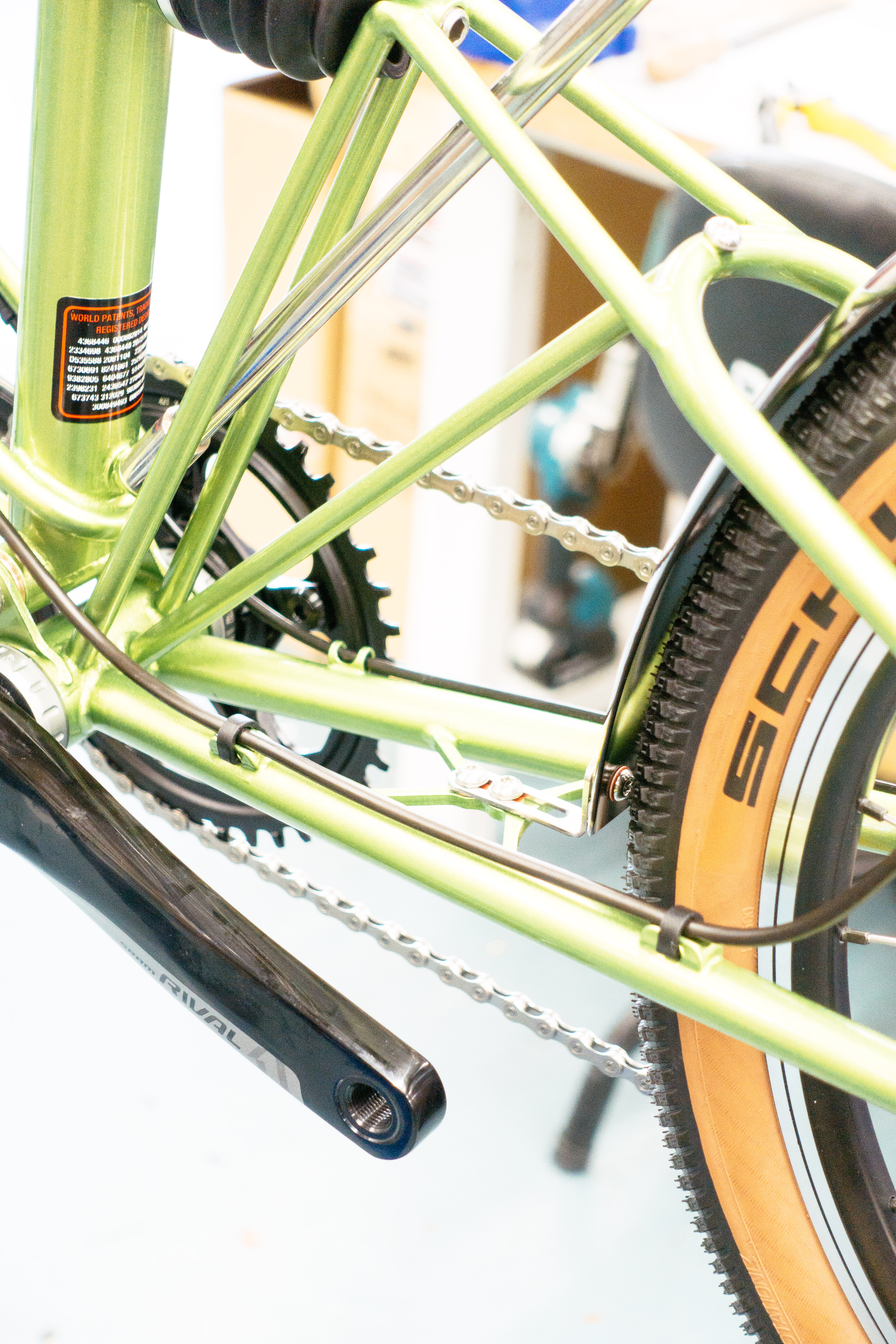
Mudguard mounts are a must for a machine with designs on mucky pathways.
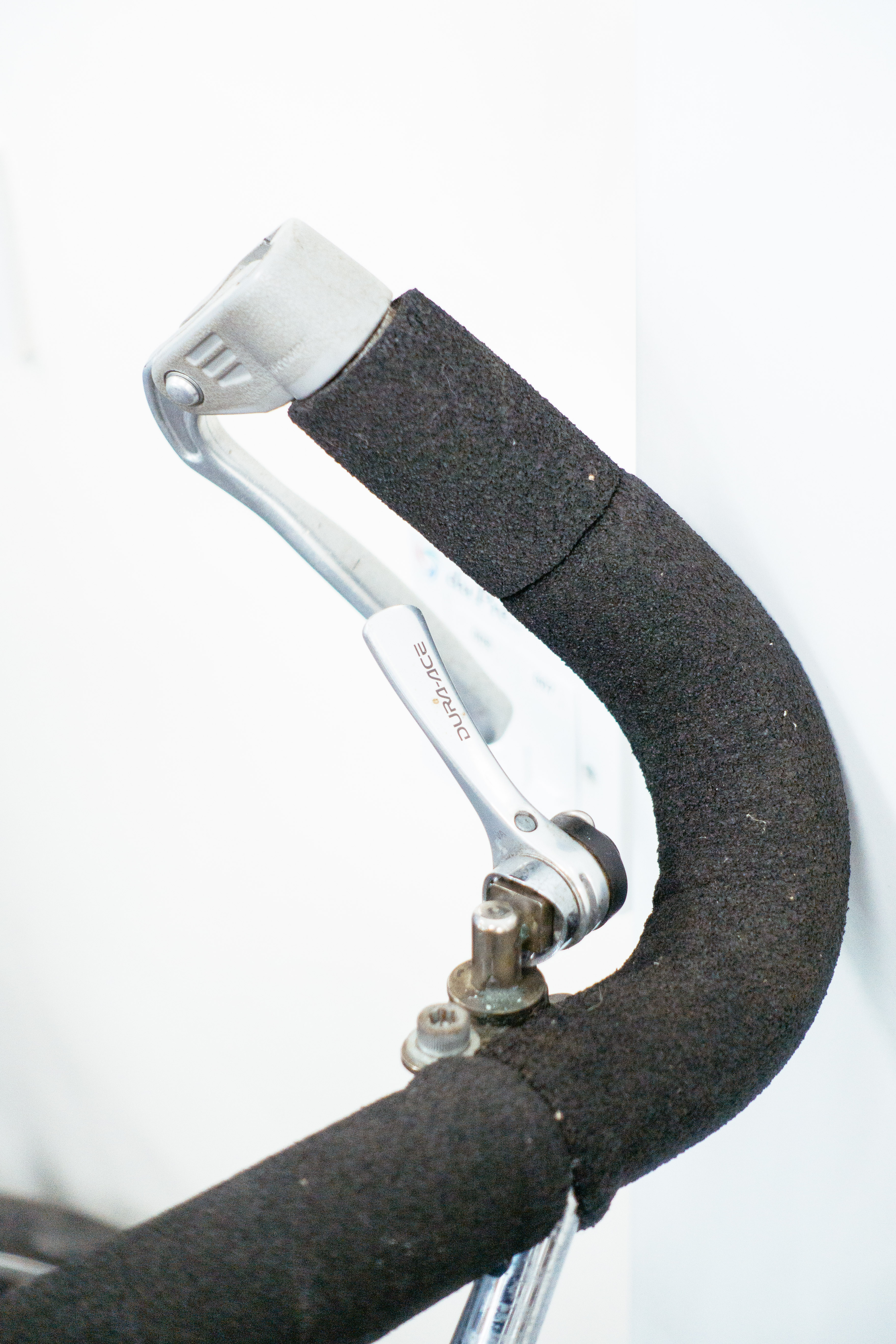
I've never seen a Dura-Ace shifter in this configuration I must say!
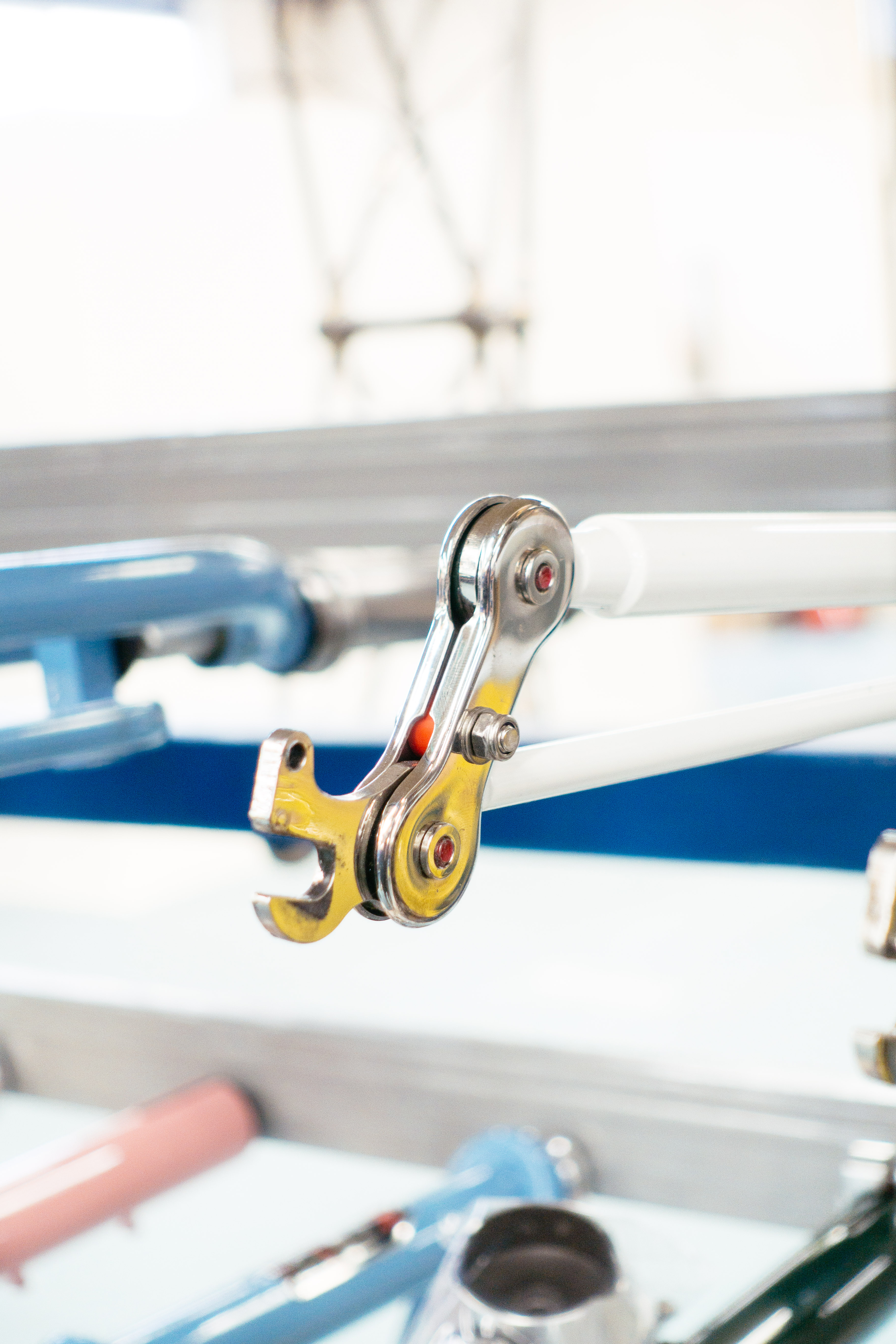
Here's the front suspension linkage, common across the majority of models.

It takes some time to get your eye in with a Moulton frame. This is a rear end, though the front if the bike is facing into the image. The large socket on the seat tube houses the rear suspension.
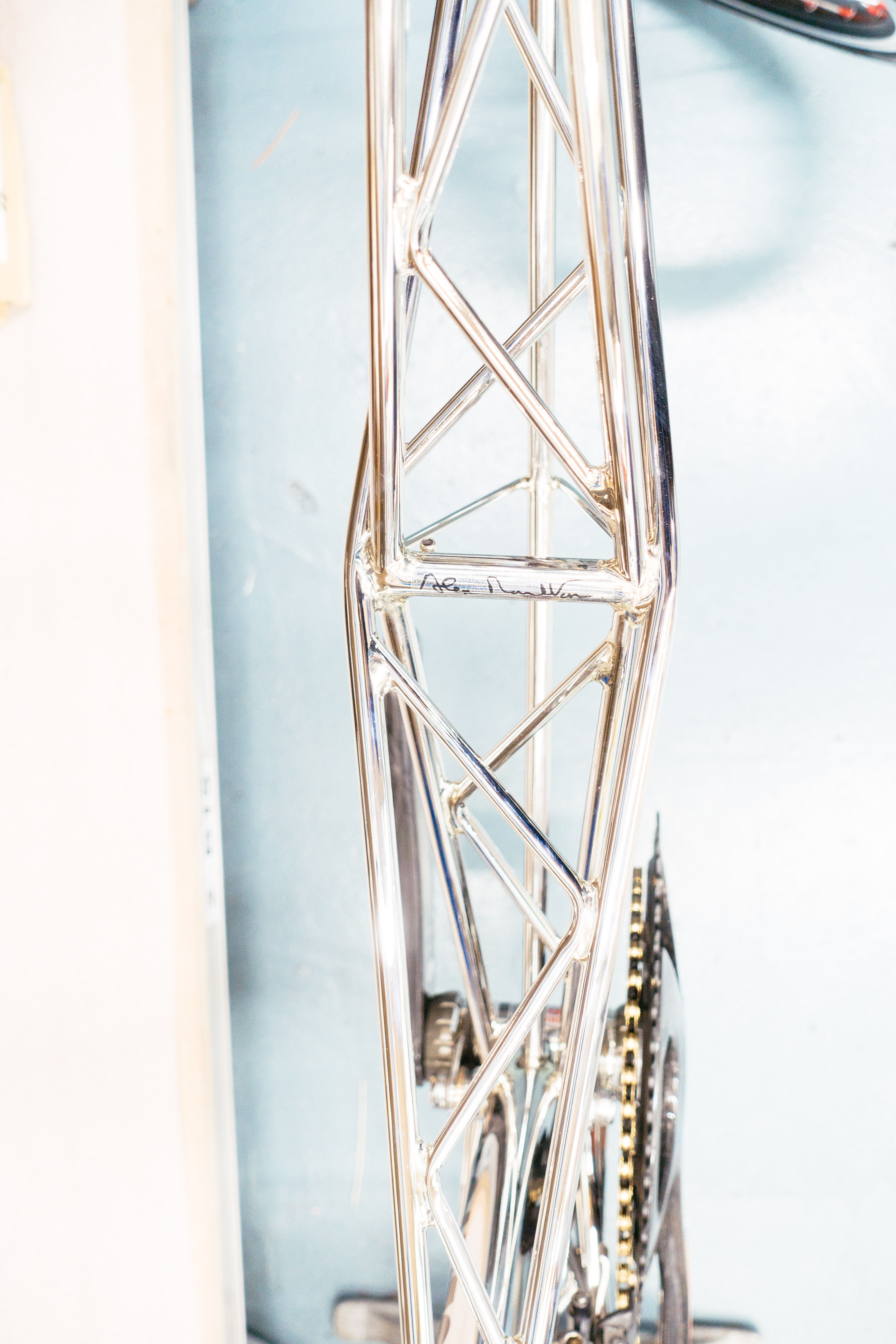
Here's another Double Pylon, highly polished, and running Campagnolo Super Record.

Veiled by well used PVC dust strips, an enormous polishing station stands in readiness for its next visitor.
While often mentioned in the same breath given that both use small wheels and both are packable, the Moulton models aren’t what you’d think of as folding bikes. They are far more akin to a breakaway frame, designed for ease of transport, but not regular disassembly for commuting. Also unlike a Brompton, Moulton bikes can accept standard components. I saw a couple of extremely handsome, highly polished numbers running cable-actuated Campagnolo Super Record.
Bicycles do tend to reflect their place of manufacturer, in a similar way to the phenomenon of dog owners resembling their pets. So Colnago is prim, fettled, and a little haughty, the Moultons I saw were full of English sensibilities. Nuts and bolts on show, engineering first, looks second; the sort of bike that would marvel at a suspension bridge, and turn its nose up at showy footwear.
Is there anything we've missed? Let us know in the comments below, and stay tuned to Cyclingnews for all the race results, news and features from our team on the ground throughout the classics season.
Thank you for your Cyclingnews subscription. We use our subscription fees to be able to keep producing all our usual great content as well as more premium pieces like this one. Find out more here.






